The following collection of property expert commentary delves into a range of topics moving into 2019.
Rolled out for the second year (see the 2018 version), perhaps unsurprisingly, Brexit’s impact on the market remains a common theme. Yet, while gauging the exact effects is anyone’s guess, the underlying mantra of ‘keeping calm and carrying on’ prevails across this year’s contributions.
This is not to understate the risks. Potential interest rate hikes, negligible capital growth (at best), affordability constraints, and the wind coming out the sails of London’s global hub status are a handful of factors that could spell danger for the over-exposed. For landlords, the tightening screws resulting from Section 24 and ever-higher barriers to entry continue to shake-up the industry for the worse. 2019 is also likely to be a testing year for emerging operators in the build-to-rent, property crowdfunding, online house sales and lettings sectors.
But where there’s panic there’s opportunity. The demand for housing – owner-occupied and rental – shows little sign of abating. Savvy investors will adapt to the cycle’s positioning accordingly and look to reap the benefits of a buyer’s market in the event of a downturn.
To automatically scroll to the specific commentary link of your choice, click on the links in the drop-down contents box above. You’ll also see an arrow towards the right which can be used to return to the top of the post.
The Property Investor’s Blog would like to thank all contributors for their extensive input. It’s genuinely appreciated and we’re sure the content will serve readers well as 2019 progresses. Please feel free to send over your comments and thoughts to ruban@psinvestors.co.uk.
Chief Economist at the Royal Institute of Chartered Surveyors (RICS), Simon Rubinsohn
 “Housing market activity set to weaken again in 2019: The UK residential market has continued to struggle against several well-established obstacles over the past year. Affordability issues, a lack of stock, political uncertainty and the prospect of further interest rate rises have all been factors seemingly weighing on activity to varying degrees.
“Housing market activity set to weaken again in 2019: The UK residential market has continued to struggle against several well-established obstacles over the past year. Affordability issues, a lack of stock, political uncertainty and the prospect of further interest rate rises have all been factors seemingly weighing on activity to varying degrees.
Sentiment has remained relatively subdued as a result, with new buyer demand tailing-off gradually throughout much of 2018. Sales volumes have also weakened during the past twelve months, while house price inflation has continued to cool at the national level. In the near term at least, we remain unconvinced that activity trends will break away from the recent sluggish picture.
Nevertheless, tackling the challenge around supply and affordability remains a primary goal on the domestic political agenda, with the prime minister announcing a scrapping of the local authority lending cap for housebuilding in the latest attempt to boost delivery. Just how effective the policy measure will be in lifting housebuilding remains to be seen, but, either way, the government still faces a huge task in reaching their 300,000 new homes per year target 2022.
Rental growth to accelerate slightly: The challenge around supply is no less of a problem on the lettings side of the residential market, with policy changes in recent years not helping in this regard. The additional Stamp Duty surcharge payable for buy-to-let investments has certainly had a lasting impact on slowing numbers of landlords entering the market.
Furthermore, the phasing out of mortgage interest relief, with further reductions still to come over the next few years, is also being factored into investors’ decisions. As it stands, the RICS indicator tracking landlord instructions coming to market has already been in negative territory for ten successive quarters. This is the longest stretch of declining supply in the rental market since the series began in 1999.
On a more positive note, according to the British Property Federation, institutional development of purpose-built rental properties has picked-up. The number of completed build to rent units increased by 26% in the twelve month to Q3 2018, now standing at 26,000. The pipeline going forward also appears strong, with construction underway on a further 42,000 units while 64,000 are in planning. That said, considering there are an estimated 4.6million households in the private rented sector, these numbers remain on a pretty small scale.”
Simon Rubinsohn @RICSnews – Chief Economist, Royal Institute of Chartered Surveyors (RICS)
Partner and Head of UK Residential Research at Knight Frank, Gráinne Gilmore
 “The political uncertainty thrown up by the lack of clarity around the UK’s future trading relationship with the rest of the world is having ramifications in all UK sectors, not just property.
“The political uncertainty thrown up by the lack of clarity around the UK’s future trading relationship with the rest of the world is having ramifications in all UK sectors, not just property.
However, when looking to the future, the Brexit noise can threaten to drown out everything else. It is worth putting in some earplugs to examine the other fundamentals of the housing market, as they will determine what happens in the years to come, once the Brexit dust settles.
Affordability, for example, is a key issue. Average house prices are around 22% higher than at the previous peak of the market in late 2007, but, in London, prices are 60% higher. In the South East, average values are 37% higher. This growth in house prices has pushed the ONS’s measure of affordability (house price to median residence-based earnings) to 13.2 in London, up from 8.4 in 2007.
The sales market has been thrown into sharper focus by slowing activity in some parts of the country. It’s no less of a factor in the rental market, however, where policy changes for landlords are affecting demand and supply dynamics, and pricing, in some parts of the UK.
The housing market, as with all markets, can absorb and adjust to change. Uncertainty is the most challenging factor of all, so sooner is better when it comes to a Brexit outcome.”
Grainne Gilmore @ggilmorekf – Partner and Head of UK Residential Research, Knight Frank
Director of Savills Residential Research, Lucian Cook
 “Brexit angst is a major factor for market sentiment right now, particularly in London, but it’s the legacy of the global financial crisis – mortgage regulation in particular – combined with gradually rising interest rates that will really shape the market over the longer term. That legacy will limit house price growth, but it should also protect the market from a correction.
“Brexit angst is a major factor for market sentiment right now, particularly in London, but it’s the legacy of the global financial crisis – mortgage regulation in particular – combined with gradually rising interest rates that will really shape the market over the longer term. That legacy will limit house price growth, but it should also protect the market from a correction.
On London: House prices have risen by 72 per cent over the past ten years, well ahead of any other region. The average home buyer with a mortgage now pays just under £429,000 and has a household income of almost £76,000 (58 per cent higher than the UK average). Even with borrowing at over four times that income, these households still need a deposit of £123,000.
Small falls (-3.5%) are expected in London’s mainstream market next year, before values bottom out in 2020 and tick up steadily from 2021. Price growth over the next five years is forecast to total 4.5 per cent.
The prime London markets are less dependent on mortgage borrowing and will outperform the mainstream. The UK capital is expected to remain an attractive place to live, work and own residential assets, supporting12.4 per cent price growth in prime central London by the end of 2023.
On the Regions: At this point in the cycle, the highest price growth is expected in the lower value markets much further from the capital, which have seen nothing like the 10-year price rises seen in London – just 1.9 per cent in the North and 5.8 per cent in Scotland.
The Midlands, the North of England, Yorkshire and Humberside, Scotland and Wales all have the capacity for borrowing to increase relative to incomes, even allowing for higher interest rates, and this will support price growth ranging from 17.6 per cent to 21.6 per cent across these regions.
Key regional economies – most notably the metros of Manchester and Birmingham – have the capacity to outperform their regions attracting both local and investor buyers.
Wales will perform in line with the Midlands as it has done in previous cycles, but it is a hugely diverse market. There may be increased housing demand crossing over from Bristol once the Severn bridge tolls are abolished.
Scotland, which has only recently returned to pre-credit crunch peak, is performing strongly, particularly Edinburgh and Glasgow, which have seen prices rise 8.9 per cent and 7.0 per cent over the past year, respectively.
Rental Market Trends: Rental growth is expected to track house price growth, averaging 13.7 per cent over the next five years. Tightening access to mortgage finance and limited social housing supply is driving demand for privately rented homes at all price points. This is particularly true in London, where rents will rise by 15.9 per cent.
Until the market sees a significant injection of build to rent stock, rental demand will outstrip supply and rents will rise. Investor buyers requiring borrowing are expected to focus on higher yielding markets and this will put further upwards pressure on rents in some of the most expensive rental locations.
Transactions: Transactions have fallen from 1.619 million in 2007 to around 1.145 million this year, but are forecast to remain stable over the next five years, though the market mix has changed.
Cash remains king and cash buyers now account for almost a third of all sales (31%). The bank of mum and dad has provided important support to first-time buyer numbers and, judging by receipts from the three per cent surcharge for additional homes, cash is also an important component of investment demand, Savills says.
Mortgaged first time buyers, the only buyer group to have expanded since 2007 – from 359,000 to 370,000 this year – continue to be supported by Help to Buy and the bank of Mum and Dad. Numbers are expected to remain robust despite the prospect of a less generous, more targeted Help to Buy, with a fall of just -2.7 per cent anticipated by 2023.
Mortgaged home mover numbers have fallen dramatically since 2007 as existing home move home less frequently. Numbers are down from 653,000 to 370,000, but having adjusted for stress testing of borrowing, are expected to remain constant over the next five years.
Buy to let buyer numbers will continue to come under pressure. Stamp duty and mortgage-interest tax relief changes have led highly leveraged investors to rationalise portfolios or pay down debt.”
Lucian Cook @LucianCook – Director Residential Research, Savills
Property Expert, Henry Pryor
 “Things are going to get worse before they get better. In Q1, the run-up to our actual divorce at the end of March there will continue to be people who have to sell. Death, debt and divorce – the three D’s as we call them in the industry will continue to drive the sale side but how many people ‘must’ buy? The only ones I think who will be confident doing so will demand something for the risk they will think they are taking which in most cases will be a discount on the price. Housing market statistics are based on deals done three or four months earlier, on average 60 days before the sale completes so regardless of whether we crash out on 29th March or enter a new golden era the statistics in May, June and July will show prices falling. This may result in buyers panicking that prices are still falling after Brexit resulting in more uncertainty and the cycle gathering its own downwards momentum.
“Things are going to get worse before they get better. In Q1, the run-up to our actual divorce at the end of March there will continue to be people who have to sell. Death, debt and divorce – the three D’s as we call them in the industry will continue to drive the sale side but how many people ‘must’ buy? The only ones I think who will be confident doing so will demand something for the risk they will think they are taking which in most cases will be a discount on the price. Housing market statistics are based on deals done three or four months earlier, on average 60 days before the sale completes so regardless of whether we crash out on 29th March or enter a new golden era the statistics in May, June and July will show prices falling. This may result in buyers panicking that prices are still falling after Brexit resulting in more uncertainty and the cycle gathering its own downwards momentum.
I don’t think that the housing market is going to test the Bank of Englands models by crashing by 30% but I do expect prices to slip by 10-15% – the discount that most buyers I imagine will demand if they are going to commit to what for most will be their most expensive single purchase. Savvy sellers will need to remember that they can make up for this by negotiating similar discounts on what the go on to buy.
As always there will continue to be regional disparity, prices in some parishes will rise whilst others will fall further. As Phil & Kirsty remind us, it’s about location, location, location. Best in class will always sell and will always be sought after.
London and the South East have seen the real house price growth over the last decade, they stand to lose the most but I expect rental prices to slide back too. Brexit is just one iceberg that we need to navigate a way past in 2019 – politics, the economy and confidence, in general, will all have a significant part to play on prices. If I’m honest, I don’t know what’s going to happen to prices in the medium to long term but one thing you can be confident of is that a house will always be worth one house.”
Henry Pryor @henrypryor – Property Expert
Land, Planning & Development Expert and CEO at Millbank, Paul Higgs
 “In terms of my personal approach, I’ve always been risk averse and detail orientated – which is fundamental in property development as it really is a super risky business, even at the best of times. With any deal, I spend a lot of time researching every aspect thoroughly and exploring all the exit options given various scenarios. Ultimately, I want to create maximum value from the start and a decent ‘buffer’ regardless of where the market is heading.
“In terms of my personal approach, I’ve always been risk averse and detail orientated – which is fundamental in property development as it really is a super risky business, even at the best of times. With any deal, I spend a lot of time researching every aspect thoroughly and exploring all the exit options given various scenarios. Ultimately, I want to create maximum value from the start and a decent ‘buffer’ regardless of where the market is heading.
Over the last few years, I’ve taken an even more cautious attitude to anything I want to get involved with. Obviously, no one can predict the market or know what’s really going to happen – but as I’ve been through a few crashes, I’m well aware of the signs, potential triggers and where things might end up.
Prior to the Brexit vote, for example, I suspected that if we did vote to leave there would be a great deal of uncertainty in the market. The market obviously hates uncertainty and in development everything is exacerbated further because of the long timescales involved in the process. I didn’t want to be in the middle of building and selling if the vote was made to exit, or worse still when the time approached to actually exit – i.e. now. As a result, for the past couple of years I’ve been focusing on adding maximum value to land, which is always my strategy actually, but with a view to flipping sites with planning rather than holding them to build-out.
London and South East prices have plateaued for the last year and a half in reality so I’ve also been a bit more involved helping-out JV Partners on bigger sites in areas like Birmingham, Liverpool and Leeds, where the market has largely continued to move in the right direction.
Obviously the more traditional strategies like buy-to-let have become harder (due to the SDLT changes, Section 24, increased regulation etc.). As a result, many property investors have shifted into development thinking it’s the ‘next best thing’.
What’s often forgotten is that property investment and property development are massively different things. People think that if they have been in property for a while and maybe have a large portfolio of single lets or HMOs, then jumping into development makes logical sense when, in fact, there’s a very steep learning curve.
As a result, there have been lots of new entrants coming into the development space in recent years who are buying sites on the market, bidding too much, overpaying and generally getting their figures wrong. Often, people can get into a mess and the market comes to the rescue. But where we are now in the market, many of these people won’t be so lucky. These questionable deals are starting to hit the market and come to light. The units are not selling for as much as originally hoped or quickly enough. With highly-leveraged deals some funders having already started pulling the plug. My expectation is that these trends will continue big-time into 2019.
Therefore, my advice is to be careful who you listen to as many out there really do not have the necessary experience to get involved in what is a complex business. Property development can be very high-reward because it’s very high-risk.”
Paul Higgs @Paul_Higgs1 – Land, Planning & Development Expert at Millbank Land Academy and CEO at Millbank
CEO at Inspired Asset Management and Inspired Homes, Martin Skinner
 “We expect 2019 to continue in the same vein as it is currently until Brexit is resolved. Whilst we remain confident the UK will agree a deal, as long as there is uncertainty, some buyers will postpone their purchase. Once a deal is struck, we expect confidence to return to the market, however, price growth will be moderate, linked to wage growth, as the market continues to be owner occupier rather than investor led.
“We expect 2019 to continue in the same vein as it is currently until Brexit is resolved. Whilst we remain confident the UK will agree a deal, as long as there is uncertainty, some buyers will postpone their purchase. Once a deal is struck, we expect confidence to return to the market, however, price growth will be moderate, linked to wage growth, as the market continues to be owner occupier rather than investor led.
2019 will most likely continue to be a buyer’s market and competition between developers will mean there are deals to be had such as solicitors fees paid and free furniture packs. For this reason, and with mortgage rates still very low, it’s actually a good time to buy if you’re an owner occupier.
If you’re a first-time buyer, you’ll also benefit from zero stamp duty on the first £300,000 of a purchase up to £500,000, meaning you’ll only need your 5% deposit to become a homeowner when using Help to Buy.”
Martin Skinner @MartinSkinner – CEO, Inspired Asset Management and Inspired Homes
Founder and Director at the TrustedLand Directory & The Developers Boardroom, Alex Harrington-Griffin
 “In terms of land and planning, there is no doubt that access to quality site opportunities around the South-East has was a struggle in 2018, as most vendors without motivation that had access to the outside world will know that if they’re looking for best returns, they won’t get it now. Therefore, I certainly expect a dramatic shift, as we pass through Brexit and banks tighten purse strings, that site acquisition strategy, and type, adapt dramatically for forward-thinking and astute buyers.
“In terms of land and planning, there is no doubt that access to quality site opportunities around the South-East has was a struggle in 2018, as most vendors without motivation that had access to the outside world will know that if they’re looking for best returns, they won’t get it now. Therefore, I certainly expect a dramatic shift, as we pass through Brexit and banks tighten purse strings, that site acquisition strategy, and type, adapt dramatically for forward-thinking and astute buyers.
More distressed site purchases, more developer-developer and landowner-developer Joint Ventures to mitigate risk and embrace transparency. I expect small and medium land buyers will be looking at areas of the market and site variations not previously considered, creating products that are somewhat out of their usual remit, or that break the mould in terms of design and style, to ensure that their product stands out and certain buyers will pay extra for that unique product.
The widespread adoption of technology and mapping tools by both experienced and new developers to access land opportunities is growing rapidly, with buyers taking it upon themselves to contact owners. However, the smart ones will listen to vendor feedback in terms of the volume of contact, and start to consider innovative ways to help their brands and bids stand out, and hopefully use transparency and trust to win opportunities, through collateral and open book appraisals. The world is becoming more transparent, not less, and a lot of vendors are now wise to this and what they can find online.
Finally, I would expect we see a move by SME resi developers, in line with the monthly discussions held within Developers Boardroom, into areas such as build-to-rent, retirement, co-living, micro-flats and even industrial/commercial, as established teams look to utilise their skills and experience in emerging active sectors where a long-term potential, such as baby-boomer accommodation, and to be looking at longer-hold, cash flowing asset creation.”
Alex Harrington-Griffin @Alex_H_Griffin – Founder of the TrustedLand Directory and Director at Developers Boardroom
Managing Director of the Property Developers Academy, Brynley Little
 “2018 saw the market softening in many areas in the UK which triggered the acquisition phase for those experienced within the land and new build sector. This will firmly continue into 2019.
“2018 saw the market softening in many areas in the UK which triggered the acquisition phase for those experienced within the land and new build sector. This will firmly continue into 2019.
Uncertainty and a softening of the market has reinforced our focus of acquiring sites for both socially and locally affordable homes. Affordability is a growing issue in many areas and working with Local Planning Authorities to combat this issue could see great relationships built and great deals to be done.
Sites with high value properties continue to carry a large amount of risk in the current climate. They are becoming less desirable for experienced developers and funders alike. ‘Modular’ certainly seemed to be the buzzword in development in 2018, and I’m sure it will continue to be spoken about throughout 2019. Will 2019 see Modern Methods of Construction gather significant pace from a delivery point of view rather than the spoken word, I’m not so sure. There is still a way to go for modular homes to displace traditional methods in my opinion.
There are two growing trends to be aware of that I believe will open up opportunities and potentially bring focus to those looking to either start or scale their new build business in 2019; The Rise of the Millennials and the Coming of Age of the Baby-Boomers. These two demographics represent opportunities for increased rental demand, affordable homeownership and downsizing to more appropriate accommodation.
My recommendation for 2019, if you haven’t already, is to shift your focus to acquiring land and obtaining planning for deliverable schemes for both the rental and affordable for sale markets.”
Brynley Little – Managing Director of the Property Developers Academy and Co-Founder of Your Land Partner
Director of Real Estate Policy at the British Property Federation, Ian Fletcher
 “It looks like we are going to start 2019 with the same Housing Minister in post. Possibly wishful thinking, given so many political scenarios that could unfold as a result of Brexit, but we sense a steely determination on Kit Malthouse’s part to hang around, and a wish to stop the housing minister merry-go-round.
“It looks like we are going to start 2019 with the same Housing Minister in post. Possibly wishful thinking, given so many political scenarios that could unfold as a result of Brexit, but we sense a steely determination on Kit Malthouse’s part to hang around, and a wish to stop the housing minister merry-go-round.
The overall supply of new homes will likely reach 240,000 homes annually – once seen as a significant milestone, but now just a stepping-stone towards 300,000 homes per annum. In addition to much-needed firepower behind other housing sectors, I am fairly confident several big Build-to-Rent transactions will take place in 2019, as larger institutional investors seek to acquire a piece of the action.
Brexit will continue to overshadow the Government’s domestic legislative programme, with several big issues in the housing sector requiring legislation – leasehold reform, implementation of the Hackitt Review, single ombudsman – getting delayed. And, council house building will get off to a slow start, hampered by a lack of skills and capacity. There will also be a stiff test of the Government’s financial credentials as the Chancellor conducts his spending review. Council finances will be a big issue, as several local authorities can cut no more.
And, for the cherry on the cake, I’m going to hazard a guess and say an independent high-profile contender will throw their hat into the ring for London Mayor.”
Ian Fletcher @BritProp – Director of Real Estate Policy, British Property Federation
Founder & CEO at Realyse (Housing Market Intelligence), Gavriel Merkado at Realyse
 “How to predict the future in an uncertain world
“How to predict the future in an uncertain world
Time and again I find myself being asked: What about the future? What can you tell me about what will happen tomorrow? Next week? Next month? Next year? In this article we’ll play the dangerous game of plotting the future course for the UK market – breaking down the key factors that will have a significant impact on housing prices in 2019.
Before we get started however, it’s worth exploring exactly why trying to see into the future is so problematic, and why using a rational approach can lead to better (and far more likely) predictions grounded in data. Foresight of coming events used to be so valuable that in ancient Greece the Oracle of Delphi could lay claim to being the most powerful woman in the world.
When a vast Persian army invaded Greece and the Oracle was consulted for guidance, she told the Athenians to “trust in a wooden wall.” Personally, I would have gone out and built a big fence, but instead this was interpreted as an instruction to construct a fleet of wooden ships. As a result, history took a different course, and the Persians were halted.
This highlights the problem with attempting any forecast; the sheer complexity of the present moment. The endless number of different variables that can have a bearing on every possible outcome, even in systems that are governed by determinism and clearly quantifiable principles, make them near impossible to predict. The mystery element is what fascinates (and frustrates) us when considering the future.
Let’s start with a simple example. You could forecast that if you were holding a ball, and then decided to let go of it, the outcome would be the ball falling to the ground (thanks gravity!) and anyone could pinpoint with great precision where the ball will land.
Now, try throwing the ball at a specific point on a wall. The distance, time and angles of movement all start to confound the accuracy of where it will actually hit. Harder to say for sure if it’ll land perfectly every time. Finally, try throwing that ball, into the wind, with a thousand other people all throwing balls at the same time. Some argue that the majority of forecasts are unreliable because the past cannot be used to predict the future in a meaningful way, because the elements are a Markov process. However I don’t consider that to be the case when human psychology is an active part of the process.
The value of any forecast is a function of the deviation from the actual, the time span and the perceived value it has for the recipient of the forecast (usually monetary). So if we return to our earlier example, telling you with absolute certainty that the ball I dropped is going to land on the floor in one third of a second, has almost no value at all.
Telling you that the ball I dropped now, in the year 2317, is going to roll under the left wheel of the future robot king and cause it to catastrophically malfunction, is actually also pretty much worthless, for a different reason. Because of the finite nature of the human lifespan, we often devalue long term forecasts, much to the chagrin of many environmentalists.

But, we digress. I have been asked to forecast the relatively near-term future, of house prices, here in the UK and for 2019. So, firstly, some definitions and ground rules:
House prices – The median price change of residential property, in aggregate, not weighted by value. So if a £1m house goes down 10% and £100k house goes up 10%, the median change is 0%, not -9%.
The UK – All of what is currently considered the UK at the time of writing, regardless of what happens with any EU issues around Northern Ireland and Scotland.
2019 – January 1st, to December 31st.
What do we know about the largest inputs which will be affecting our forecast?
From a Macro perspective: Interest rates and credit availability, global economic growth (or decline), auto-correlation of activity, inflation, UK economic growth, supply & demand.
From a Micro perspective: Individual expectations of housing markets, pricing, and macro factors, as well as changes in fashion, personal wealth etc…
Interest Rates & Credit
For the past ten years there’s been talk of the Bank of England raising base rates, and then finally it happened towards the end of 2017. The forward curve has been upward sloping for almost as long as I’ve been looking at it, so just because there is an ‘expectation’ of rising rates, doesn’t mean anything, as the expectation has been there for the past decade and hasn’t happened. What it will come down to, like so many other things in the near future, is what happens once the UK leaves the EU.
If there is a poor economic situation following Brexit, it may result in immediately lower rates in the UK, even negative rates (as have existed now in Europe for several years) as the Bank of England aims to improve the economic environment. Conversely, if there is a run on the currency, then the BoE may choose to raise interest rates to stop the depreciation, as was done in 1992 during the ERM crisis.
In a muddled-deal situation, with some kind of halfway house of the UK/EU not being entirely resolved, it is likely that rates would stay around the same level or slightly increase, dependent on the global economic environment.
In a good economic situation, following the UK leaving the EU, whereby either the UK gets a good deal from the EU or quickly creates favourable new deals with other significant trading partners, rates may actually increase.
Similarly, credit availability will likely be impacted by the outcome of Brexit votes, with a poor economic situation leading to looser credit availability and perhaps even returning to QE.
Overview – Rates remain the same.
Global Economic Growth
What is interesting beyond the political mire of the ongoing spat between the UK and EU is actually the changing financial and economic characteristics of the rest of the world around them. While the majority of the EU has been lagging far behind, the UK has over the past few years been returning to some sense of economic well-being. Meanwhile, the US has been steaming ahead. Markets are up, interest rates are up, growth is up, incomes are up. The US is now in the second longest ‘bull run’ in history.
However for a variety of reasons, US yield curves briefly inverted last week, a tell-tale sign that moods are shifting and the party may well be over in a year or two. As the world’s largest economy, when the US sneezes, the world catches a cold. While it is slightly outside the scope of this one year forecast it is worth keeping any eye on what happens across the Atlantic in 2019.
In the world’s second largest economy, China, we know growth is slowing, power has become even more centralised in Xi Jinping (creating decision risk) and the enormous debt taken on by the corporate sector (total debt in China is now equivalent to 300% of GDP) increases their economic risk weighting. The UK’s recent relative currency weakness does potentially create a nice buying opportunity for overseas buyers, if they believe there is more economic upside in the UK.
Why is this relevant to us? Keep in mind that a large proportion (if not the majority) of buyers of newbuild properties in major cities UK are overseas buyers, and that demand from those foreign buyers has been largely supporting the current price levels of new property developments. If those buyers go, because of changes their local economies, the support for the high prices in the UK goes along with them.
Overview – Slower growth globally
Auto-Correlation and a buyers market
Have you ever noticed how people talk about ‘property prices going up’ in an area, and there’s some kind of palpable excitement to it, like a panhandler telling you about a fresh seam of gold they’ve just heard about up yonder? Word of mouth spreads, and other people start buying in the same area, hoping to get in on the wave of price increases while they still can, this pushes prices up further, encouraging the next batch of people to buy in before it’s too late.
The same buying behaviour can be seen whether it’s in houses, cryptocurrency or the latest fashion sales. Property prices are auto-correlated, and because of this we can often predict that the future will closely resemble the present. What we’ve seen over the last year is a significant decrease in the volume of transactions. The uncertainty around Brexit, and the already extremely high prices in many parts of the country, as well as secondary impacts from changes in stamp duty and the changing dynamics and spending power of overseas buyers have all led to reduced volumes overall.
These reduced volumes are likely to continue until such time as something significant changes in the political and economic environment, which gives people more clarity on what the immediate future may be like. The housing market in Australia is currently going through this period of auto-correlated decline now, having gone through an extended period of price increases. People there are now waiting for the market to bottom out, but it’s expected to continue to decline by a further 10%, so they keep on waiting. Lower volumes doesn’t necessarily create a directional impact on the market, although some would claim that it does.
As every transaction must have a buyer and a seller, all that a lower volume of willing buyers and sellers does is to push pricing in favour of either the buyers or the sellers overall, depending on which group is more desperate. The likelihood is that someone who needs to sell, needs to sell, they have to do it. For example, the seller has to pay their inheritance, alimony, move to somewhere else etc. Yet there is no such thing as someone who needs to buy, since you can always rent, or find somewhere else.
In a market with fewer deals going on, the impact of the desperation of sellers, can over time, cause them to drop prices well below what they would previously have accepted.
Overview – Expect low volumes to remain, and for that to push down on prices.
Inflation
Ever hear of stagflation? Its when you get a low or negative growth economy, coupled with high inflation, effectively the inverse of the normal economic relationship. Usually inflation follows real growth, growth goes up, and then so does inflation a little later, and then in theory central banks use interest rates to control growth and thereby limit inflation, or at least the expectation of inflation.
However, you can have a situation where there is low growth but rising inflation, where you’re paying more for the same thing (inflation) but the environment around you isn’t changing. It doesn’t happen very often, but when it does it’s caused by a shock external factor causing prices to rise. Well, how about a country leaving the world’s largest political/economic bloc as a shock? Exchange rates took the brunt of the impact of the referendum vote, resulting in higher import costs for the UK (and interestingly, putting a real quantifiable value on voting behaviour, but perhaps that’s another story).
If the economy continues to work ‘as normal’ in the coming year then inflation will simply be a factor of economic growth and commodity costs, which are not expected to be particularly high in 2019. However, if the exit from the EU creates further currency devaluation, then it could lead to higher inflation as the cost of imports rises. As inflation rises, people beginning to mentally price in that inflation will continue, causing them to change their buying behaviour and pricing, resulting in a spiral of unwanted inflation. Inflation makes it harder to price assets and commodities in real time, as if inflation is higher, the price of the asset may be changing faster than you can keep up, creating all kinds of inefficiencies, and often lowering the number of transactions. The Bank of England is also forecasting higher than ‘normal’ inflation for 2019 at 3.2%.
Overview – Possible negative risk, keep an eye on FX markets
UK Economic Growth
There are a great many pundits and think tanks out there making economic forecasts, usually picked up on by news outlets depending on their own particular political bias. Some come from very important sounding organisations, and most forecasts are usually wrong. As we’ve shown, it is incredibly hard to make an accurate forecast of a complex system where the majority of parts are unknown and the relationships between them can often only be guessed at.
However one organisation I believe has come closest to proving itself accurate more often than not is Oxford Economics. Their forecast for 2019 in 1.5% GDP growth in the UK, which is somewhere between 2017 and 2018 results. So the expectation is that next year will be somewhat like this year and the year before. It could be that a no-deal situation in Brexit results in import and export tariffs, increasing both the cost of purchases of EU stat products in the UK and the cost of EU states purchasing UK products, that may be offset by opening up the UK to greater trade with the rest of the world. Conversely a trade deal with the EU could maintain the status quo.
Overview – No change
Supply & Demand
The official population of the UK is c.66M, however it may well be higher, and according to government statistics there are 25 million homes (although our own figures show a higher number). So there are 2.6 people per house in the UK. Germany for comparison comes in at 2.2 people per house, the USA at 2.4 and Japan, (often characterised by very tight living conditions in its major cities) at 2.5 people per house. Of course there may be different styles of living in those countries, for example people living with their parents longer, or demographics resulting in smaller family units (which i’m not taking into account) this is simply a guide.
So it would appear that the UK is undersupplied in housing by at least 4% (if we want to catch up with Japan), if not more likely 10%-15% (if we want to catch up to somewhere near the USA or Germany). Which is roughly equivalent to either 1 million more homes, or 3.75m depending on which comparison you prefer.
The UK is currently building ~200,000 new homes per year, although the average over the past few years is closer to ~150,000. So it would take at a minimum, assuming a constant population level, five years for supply to meet demand. In reality, the population of the UK is increasing by about 400,000 people per year, so all of those new houses are actually going straight to new additions to the population.
Realistically for supply to meet demand, the UK, over a five year period based on the persons per house found in other countries, would probably have to produce close to 800,000 new homes per year over five years, or 400,000 over ten years. This is unfortunately very unlikely – in fact almost guaranteed – not to happen.
So supply is constrained, however so are incomes, thus the only logical choice for prospective home buyers is to either move further afield from their place of work (maybe buy transportation stocks?), or to rent instead. Additionally, the uncertainty around the housing sales market may encourage some people to either continue renting or start renting rather than risk a poorly timed or unaffordable purchase.
Overview – Strong positive for ‘commuter towns’ and central renting locations, negative for central sellers.
Individual Expectations
This is a tricky one to understand, however sentiment can often drive markets just as much as, if not more so, than fundamentals. Individual sentiments and expectations, in aggregate create economic action. So what are those individuals expecting? Looking at the PMI (purchasing managers index) and the CCI (consumer confidence index) shows that while both are down somewhat over the year, neither is in a particularly different position to where it has been over the past couple of years. So the expectation in that sense is that next year will be much like the past couple of years.
Overview – No change
Personal Wealth & Income
Why have property prices gone up in the past half decade? Did everyone suddenly get a lot richer? Did the population increase exponentially? Did half the supply of houses in the country disappear? Nope, two things happened, interest rates fell, and lending increased. However, at the same time, banks changed their lending requirements, generally forcing a requirement for higher deposits. Meaning that housing became very much dependent upon the ability to raise a deposit, and this was often found from the equity held in a property that is already owned.
While on average people have gotten somewhat wealthier, it hasn’t been by much, and arguably a large portion of the population isn’t better off than they were a decade ago. Recent economic figures don’t indicate that this trend will change, with some recent metrics marginally positive and others marginally negative, effectively cancelling each other out.
Meanwhile, the income-to-price ratio of most residential properties has already reached, or is in excess of, the maximum sustainable level. With that in mind I don’t see a huge change resulting from personal wealth and income over the year that lies ahead.
Overview – No change.
Summary Overview
To sum up, we have the following results:
| Factor | Impact on prices |
| Personal Wealth & Income | No Change |
| Individual Expectations | No Change |
| Supply & Demand | Positive for rents, commuter towns, negative for central or high price locations |
| UK Economic Growth | No Change |
| Inflation | Possible negative |
| Autocorrelation | Slight negative |
| Global Economic Growth | Slight negative |
| Interest Rates & Credit | No Change |
With all of the above in mind, I believe that the UK will see a mixture of different results depending on the location and property type. However in aggregate we’ll see modest price and rent increases primarily driven from the supply/demand imbalance, but constrained by limited changes in personal wealth and downward pressure from macroeconomic factors.
Let’s see what happens in 2019, who knows, I might actually be right!”
Gavriel Merkado @REalyse_UK – Founder & CEO, Realyse
Senior Economist at the Construction Products Association, Rebecca Larkin
 “Noticeable variations in regional performance have emerged in the UK housing market over the last 12 months and this is a dynamic that is expected to go on into 2019. The strongest price growth is likely to continue in the North West, the Midlands and Yorkshire & Humber, whilst price falls in London ripple out to the neighbouring South East and East of England.
“Noticeable variations in regional performance have emerged in the UK housing market over the last 12 months and this is a dynamic that is expected to go on into 2019. The strongest price growth is likely to continue in the North West, the Midlands and Yorkshire & Humber, whilst price falls in London ripple out to the neighbouring South East and East of England.
Regional price growth, the Help to Buy equity loan and a dearth of pre-owned properties on the market have led to an increased role for new build, which now accounts for 14% of property transactions. This has been further complemented by house builders’ offerings being accompanied by a wider variety of tenures such as shared ownership and Build to Rent in response to longstanding affordability issues.
Perhaps the biggest theme for the near-term outlook, though, centres around developments in the political and economic landscape, which are currently the great unknown for builders, purchasers, investors and forecasters alike. The last recession showed us that a significant slowdown in the wider economy will undoubtedly hit the housing market and new build activity harder. On this front, the labour market, interest rates and appetite for mortgage borrowing and lending will be the key determinants of how the housing market progresses.”
Rebecca Larkin @CPA_Tweets – Senior Economist, Construction Products Association
PRS and Build to Rent Consultant, Richard Berridge

“2019: The Year of the Consumer Renter
I get a sense that the Build to Rent sector is getting just a little bit more mature. Those of us with genuine experience of institutional PRS, across a number of disciplines, are seeing a more considered approach to the development of schemes and a shying away of viability assessments based upon a premium above upper decile rents. Now, of course, we actually have real data to interrogate. Mirroring the collaborative approach of the US Multi-Family operators, some of the UK operators actually share this information. Some don’t. Old resi’ habits die hard.
In last year’s comment piece, I estimated that we could have close to 150,000 BTR units constructed, in planning or construction by the end of 2018. According to the British Property Federation, at the end of Q3 we have close to 132,000. Not bad going. Given there’s Q4 still to report on, I guess we could end up with 140,000. This demonstrates that not only have funds become comfortable with BTR, but actually desirous of it.
There’s little let up in the growth of potential investors either; Intu are reported to be considering repurposing the airspace above their retail portfolio (although sadly little understanding of the management paradigms seem to be evident) British Land are on the verge of creating a portfolio and we have seen Cortland enter the UK market with a £4bn war chest, aspirations to deliver 10,000 units, and the poaching of Andrew Screen from TradeRisks. So, from my perspective, Brexit or not, I expect 2019 to demonstrate stronger growth than 2018.
I would caution some new entrants against seeing BTR as simply a portfolio-balancing act. Watching institutions pour funds into new schemes might give prop-co’s the confidence to enter the market, but they need to take on board the learning that has been done in designing the asset for living and the quantum leap in management. It will not be enough unless the new thinking around quality, brand, customer service, environment, and wellness are employed and fully embraced. You can’t fake good BTR.
I’ve been a little disappointed in the rather prosaic nature of BTR marketing. Illustrated, perhaps, by not grasping the opportunity Black Friday or Cyber Monday offered. 2019 will see an acknowledgement that BTR is just another consumer product and we will see cross-market expertise from other industries drive innovative marketing and advertising. That will mean much more scientific use of demographic and psychographic data in harness.
I suspect 2019 will also see a wobble in Third Party Management. My discussions with a number of investors have revealed a cultural shift away from TPM and a desire to self-manage. This is going to create some difficulties and I would expect some high profile changes in management in the coming months and some creative JV structures between operational managers and investors.
Prop-tech hasn’t quite made the quantum leap I would have expected, except for one area: AI. In ‘general’ prop-tech (if there is such a thing) there’s been an awful lot of collaboration, much talking and some mild interventions in management. But AI is the game changer and we’re waiting to see who embraces it first. My feeling is that there will be some typical caution in implementation in 2019, and perhaps a little AI ‘light’ But I think it’ll be 2020 before we see anything really exciting. It’s always worth keeping an eye on Antony Slumbers for AI development. Data mining and interpretation from more operational schemes will become a priority. The data will be ‘richer’ and will highlight what renters really want and how it can be provided.
As last year, affordability is high on the agenda and rightly so. Whilst many planning authorities are BTR ambivalent, more, especially in London, are now looking for BTR to provide as many affordable units as OMS schemes. These will not just be DMR, as suggested in the NPPG, but will comprise a range of affordability levels. Our cousins across the pond are experiencing similar affordability issues. Last year, I posted a link to Harvard’s housing review that articulated concerns over affordability. This year’s Harvard ‘State of the Nation’s Housing’ review can be found here. Figures show that 80% of renters in the US are ‘cost burdened’ and that the numbers of renters have fallen by 180,000 to 43.1m. There are two factors at play here: cheap finance has seen an uptick in home ownership and, more worrying, younger cohorts are simply not forming new households. Many staying at home longer.
We see similar trends emerging in the UK. There is a growing concern that HA’s are not fulfilling their social purpose. Tom Murtha has been critical of this. Gradually starved of grant, HA’s have become vigorous commercial entities. Whilst not intrinsically a bad thing, there is evidence that the commercial side of the HA brain has taken precedence over the social-purpose side. However, I believe that this is now recognised and in 2019 and beyond I see HA’s taking the lead in developing major BTR schemes of blended tenure with a very strong emphasis on affordability and social-purpose. 2019 will also see a rise in flat sharing, driven by affordability, and for flat-sharing platforms to be embraced by some of the BTR operators. Ideal Flatmate is one such platform that I would expect to grow exponentially in 2019.
Yields: competitive, long horizon money has driven down yields across the country in 2018 with, no surprise, London sitting at around 4.75-5% gross or 3.5-3.75% net. With 10y UK gilts at around 1.2% (at time of writing) Institutional money is still sitting on an acceptable margin. Factor in rental growth over time and the picture looks better still. However, should we see interest rates rise, and Brexit could well be a factor here, yields will certainly soften. In any event, I would now be advising an increasing of yield factor by 25-50bps. Naturally, that would see a marginal fall in capital values.
Finally, BTR mustn’t lose sight of its key differentiator; peerless customer/user experience (CX/UX). There are some new players, Cortland for instance who understand this very well and will raise standards further. So, if 2018 was the year of the BTR investor, 2019 will be the year of the BTR renter as consumer consciousness finally becomes wide-spread.
Richard Berridge @ResiRichard – MLH-Investments: Institutional Residential Investment Multi-Family & Build-to-Rent
Head of PRS and Build to Rent at PRSim, David Bond
 “With the ongoing demand for rental property, it was encouraging to see that during 2018 there was an increased focus on Build to Rent and institutional investment in the Private Rented Sector. This was acknowledged by the British Property Federation (BPF) who reported that the ever-increasing Build to Rent pipeline of units at the planning stage, or in construction, was in line to exceed 100,000 by the end of the year.
“With the ongoing demand for rental property, it was encouraging to see that during 2018 there was an increased focus on Build to Rent and institutional investment in the Private Rented Sector. This was acknowledged by the British Property Federation (BPF) who reported that the ever-increasing Build to Rent pipeline of units at the planning stage, or in construction, was in line to exceed 100,000 by the end of the year.
As we move into 2019, it is widely expected that these pipeline units will ‘hit the market’ and, with the support of institutional landlords, bring the much-needed stock to the sector and, it is hoped, satisfy the wide-ranging demands of tenants. As usual demand for apartments that are centrally located – with amenities close by – is likely to continue as is the need for single dwelling housing, perhaps near schools or local parks, for families. Added to this, however, there appears to be a growing acknowledgement that rental properties are needed for older tenants and those in the retirement sector.
A blurring of the lines between family housing – and later living – could, therefore, create a new interest in the rental sector for those semi or fully retired and who, to date, could see no transition between family housing and retirement/care living. The Centre for Ageing Better reported that, on the back of an English Housing Survey, a growing number of over 60s in the UK are renting and estimates that by 2040 a third of people aged over 60 could be living in private rental accommodation with demand for specialist retirement developments – with assured (lifetime) tenancies – potentially increasing.
For the institutional investors, therefore, it continues to be vital to understanding what tenants want – and where – and how they respond to this, whilst also, of course, considering what yields they may generate. The importance of developing strong relationships with national and regional house builders therefore remains and – even before a site is identified or planning application made – it’s crucial that an open dialogue between institutional investors and builders is maintained now and in the future.
Added to this, with the growth of institutional landlords, we are also seeing the wider use of deposit replacement schemes and PropTech playing a role in professional property management. The focus is on efficiency, performance and quality service to tenants with the ultimate aim being to help landlords retain them.
Housing has certainly been the focus of much debate during 2018 and appears to be firmly on the political agenda, but we must now wait and see what 2019 will bring and how, for the institutional landlord, and those people living in the Private Rented Sector, it directly affects them.”
David Bond @_PRSim – Head of PRS and Build to Rent at PRSim
Director at Just Do Property, Julie Hanson
 “It seems highly likely that we will see a further softening of London house prices in the short term prior to the finalisation of any Brexit arrangement. The next two years could be challenging for London but experts believe that 2020 will see the cycle turn. Many have written off London as a ‘busted flush’ in times gone by only to see the market bounce back to take centre stage. Do not fall into that trap!
“It seems highly likely that we will see a further softening of London house prices in the short term prior to the finalisation of any Brexit arrangement. The next two years could be challenging for London but experts believe that 2020 will see the cycle turn. Many have written off London as a ‘busted flush’ in times gone by only to see the market bounce back to take centre stage. Do not fall into that trap!
The South of England, especially the South-East, will likely broadly follow the same path as London house prices in the short term. It is easy to forget these are areas of the country, the South-East in particular, which have significantly outperformed the rest of the UK (excluding London) over the last decade. Property investment is a long-term activity and while short-term fluctuations do obviously impact investor sentiment, the long-term trend is still your friend.
Infrastructure investment has also brought the Midlands and the North of England into play. The risk/reward factors compared to London are much more attractive and there is a feeling that investor sentiment is changing. However, once the dust settles on Brexit it would be foolish to dismiss a recovery in London prices in the medium to long-term.”
Julie Hanson @JustDoProperty – Director at Just Do Property
Director at Garrison Property Services, Adam Lawrence
 “2019 looks like a year of considerable uncertainty as we look towards it in December 2018. We have definite activity in the UK next year – whether that be postponement of article 50, or a footrace towards a brick wall with a blindfold on March 29th 2019. The lack of skill displayed by the government in the past 12 months has truly been something to behold – if only spitting image were still around they would have had the most beautifully gift-wrapped bunch of satire, for real, delivered to their storyboards.
“2019 looks like a year of considerable uncertainty as we look towards it in December 2018. We have definite activity in the UK next year – whether that be postponement of article 50, or a footrace towards a brick wall with a blindfold on March 29th 2019. The lack of skill displayed by the government in the past 12 months has truly been something to behold – if only spitting image were still around they would have had the most beautifully gift-wrapped bunch of satire, for real, delivered to their storyboards.
A good place to start seems to be with predictions that I made at the end of last year for 2018, and see how they’ve stacked up – after all, you can then decide whether to scroll down or to bother continue reading! Here are my numbers from 12 months ago, and the actual results (numbers from land registry HPI):
- London market – capital values to be flat, best guess 0% – actual number -0.5%
- South-east England – flat/small growth, in the 1-2% region – actual number +2.04%
- Midlands regions – growth in the 5-7% region – actual number +4.15%
- North West – growth in the 3-5% region – actual number +4.5%
- Wales – growth in the 3-5% region – actual number +4.99%
- South-west – growth in the 2-4% region – actual number +2.78%
- North-East – growth in the 2-4% region – actual number +1.04%
So, overall, very pleased with that. A difficult year and I was inside the target areas 4 times out of 6, and within 1% on all regions. I expect next year will be less predictable and so am instead going to focus on the high-level metrics in order that we can try to get some kind of baseline and hopefully draw some confidence in investing going forwards.
I have spent a great deal of time this year (and do on an ongoing basis) studying the situation around the availability of credit. Many make the mistake of assuming that we should draw lessons from 2008-2010 and immediately apply them to this business cycle, or to the next recession – I am totally against that. The primary fact here is that banks are 3 times as well capitalised as they were in 2008 and are so much more robust. Hence, credit availability is unlikely to dry up – banks want to lend, shareholders want returns, and property remains one of the most secure asset classes (hence why it attracts such cheap financing).
Alongside that, perversely, the current grim economic outlook for the UK (relative to the rest of the EU, and the USA, and the rest of the world) means that the price of the 5-year bonds (the price upon which the 5-year mortgage rates are set) remains very low. There is a lack of confidence in the UK economic performance over the short and medium term. Whatever your position on Brexit, it is widely accepted that the short-term impact will be impaired economic performance, and this is keeping our mortgage rates down (tick in the box!).
Immigration statistics are worth looking at for the past couple of years, because some investors rely on housing economic migrants in shorter-term accommodation like HMOs, and there are what sound to me like some unenforceable and bonkers plans coming out of the home office as we speak which are bound to have some impact on this niche in the market. Things have already changed significantly since the referendum – some because of a level of hostility, some because of a weaker economic performance and a cheaper pound versus the Euro. Let’s not forget that the housing crisis is largely caused by population growth (most of which is not organic, it is imported), alongside cultural shifts. If we had negative migration (some have mentioned it in Brexit stress-test scenarios) this ‘ever-present’ in our market would go away and cause a potential step change. This is unlikely to play out in 2019, and also the increased populism and hostility to immigrants in central Europe will also potentially play a part in making the UK a more attractive destination again. However, the conclusion must be that any strategy reliant on immigrants is a risky one in these uncertain times.
Demand is likely to continue to increase (immigration notwithstanding) as society moves more away from the nuclear family and more towards staying single for longer but wanting own space (in urban areas). Confidence in the stock market and resale prices is likely to impact the number of housing starts downwards – these are challenging times for housebuilders. Housing prices already seem to be brutally ‘optimised’ and there seems little scope for squeezing more value out of potential purchasers. The end of Help to Buy will also have impacted 5-year and 10-year plans for housebuilders. One thing I do expect to play out in 2019 is a continued flat market in the south and London and then many of the first Help to Buy loans to come to the realisation that once the new build premium has been added, and the market has gone up and down over that 5 years, that many are left in or near negative equity, particularly when thinking about the cost of moving and the stamp duty on the next potential property. This false leg-up onto the ladder will likely see people stuck in their first homes for longer (arguably, still far better than being stuck in rental) and transaction volumes are likely to stay low.
So, it is difficult to see much good news for the market – however, because outlooks are already relatively grim – and a tough trading environment sees the introduction of mandatory Client Money Protection (CMP) insurance for letting agents in England, alongside the tenant fee ban in England and Wales, the only bright side from the industry perspective is that there is not much further to fall. Rather than being a flippant comment, this seems a fair conclusion, inasmuch as a crash is unlikely but a continued slowdown and a tough trading environment is extremely likely to persist.
With the investor hat on, I would expect strategies involving resale to owner-occupiers to be very challenging and buying and holding to be a vastly superior strategy (if it can be executed correctly!) for 2019. For any flips, I will be wanting an extra 5% margin at least, and as they are already very challenging to find, that means I will likely not be doing any in 2019! Refinancing existing stock and reviewing portfolio, alongside optimising rents, is an absolute must. Don’t sell in this market unless you absolutely have to. Good luck…”
Adam Lawrence – Director at Garrison Property Services Ltd and Group Owner of Partners in Property
Editor at Letting Agent Today and Estate Agent Today, Graham Norwood
 “Buy-to-let is clearly more challenging now than at any time during its history – but that in itself is not a reason for avoiding it.
“Buy-to-let is clearly more challenging now than at any time during its history – but that in itself is not a reason for avoiding it.
It sounds like a cliché but that doesn’t mean it isn’t true – choose locations where jobs and transport are still strong, go for secondary locations where capital values are reasonable and so rental yields will be good; and make the investment for 10 or 15 years so you have a chance of reasonable capital appreciation.
Furnish, equip and maintain your buy-to-lets well, and ensure it’s managed by a strong letting agent, because Build To Rent is coming to a location near you soon, and you need to compete with it.”
Graham Norwood @PropertyJourn – Editor at Letting Agent Today and Estate Agent Today
Founder at The Property Voice, Richard W J Brown
 “Last year I spoke about the uncertainty that surrounds Brexit having a potential drag on the residential housing market. It feels like Groundhog Day as Brexit uncertainty remains, perhaps even more so! The upshot of this is that many people have been sitting on the sidelines waiting to see what happens, which has slowed down transaction volumes. That said, there will always be people that need to move for whatever reason, so there will be some transactions, just not as many as we need to have a vibrant housing market. However, the lower transaction level has helped to keep prices stable, especially in London and the south-east, which may have dipped further if more people had to move.
“Last year I spoke about the uncertainty that surrounds Brexit having a potential drag on the residential housing market. It feels like Groundhog Day as Brexit uncertainty remains, perhaps even more so! The upshot of this is that many people have been sitting on the sidelines waiting to see what happens, which has slowed down transaction volumes. That said, there will always be people that need to move for whatever reason, so there will be some transactions, just not as many as we need to have a vibrant housing market. However, the lower transaction level has helped to keep prices stable, especially in London and the south-east, which may have dipped further if more people had to move.
From an investor point of view, Section 24 will continue to take a bite out of rental profits as the tax reduction phasing continues. Equally, additional legislation, such as the removal of the three storey criteria for larger HMOs continues to send ripples through the sector. Defensive strategies, such as company BTL purchases will continue to grow, just as they have done this year already. However, whilst the headline mortgage market seems healthy enough, this is perhaps misleading when considering how may loans are for remortgage rather than new loans. This all suggests a fairly stagnant BTL sector for the immediate future, which may slip into the red with a cliff-edge no-deal Brexit causing a lack of confidence generally.
Brexit aside, the increased professionalisation of the PRS will continue, with larger landlords and build-to-rent players dominating the growth in the sector for new rental properties. Accidental landlords will probably look to exit if their cash flow turns negative and the sector will probably continue to split into a two-speed market, with smaller ‘BTL is my pension’ investors remaining, along with the larger & professional landlords, but with some of the middle-classes potentially seeking simpler, more tax-efficient investment returns elsewhere. So, overall, I see a sluggish market with some consolidation and segmentation, as the uncertainty, continual change and cloudy political-economic situation remaining. As always though, there are opportunities for the astute or entrepreneurial investor that can adapt to the climate to capitalise, which is where I aim to be myself.”
Richard W J Brown a.k.a The Property Voice @PropertyVoiceUK | Listen to the podcast here
PropTech Influencer and Global Speaker, James Dearsley
 “The property market is starting to understand that it is going through a period of intense change. The traditional view that we are a relationship-driven marketplace is beginning to warp into the view that we are becoming a tech-enabled industry and one that is on the start of a process known as digital transformation. As a consequence, we have seen an almost ubiquitous use of the term PropTech in the past few years which is the symptom of this change.
“The property market is starting to understand that it is going through a period of intense change. The traditional view that we are a relationship-driven marketplace is beginning to warp into the view that we are becoming a tech-enabled industry and one that is on the start of a process known as digital transformation. As a consequence, we have seen an almost ubiquitous use of the term PropTech in the past few years which is the symptom of this change.
In 2019, I expect to see the real estate industry struggle with this new industry as it looks for ways to become more streamlined, efficient and customer focussed whilst trying to retain its traditional format. We have seen huge case studies of failure of so-called PropTech businesses, many of whom featured in last years predictions for 2018 in fact, but this should dissuade traditional businesses from understanding the changes being demanded by the consumer. We are all looking for better processes, improved systems, more cost-effective workflows and ultimately to see an industry transition to one that works for everyone.
There will be more failures in 2019 as the 6,000+ PropTech businesses around the world continue to find their place in an industry that is rigid and slow moving but there will be many more successes as businesses start to understand different business models, and start to evolve. One key element of this is for the industry to be welcoming of new models, work with them to understand what they are trying to do differently and come to a happy medium that means both work. Collaboration and consolidation will be a key outcome in 2019 and some will end the year key winners as digital transformation takes hold.”
James Dearsley @JamesDearsley – PropTech Influence, Global Speaker and Co-Founder of Unissu, a global PropTech search portal
Managing Director at Dataloft, Sandra Jones
 “2019 may be the year in which Brexit gets decided one way or another, when work on Crossrail is completed and Kit Malthouse celebrates a full year as Minister for Housing.
“2019 may be the year in which Brexit gets decided one way or another, when work on Crossrail is completed and Kit Malthouse celebrates a full year as Minister for Housing.
Or it may not – because, as 2018 has shown, predictions are dangerously unreliable.
There seems to be a broad consensus about what will happen to house prices and transaction volumes next year – very little and very low.
But it will vary from place to place depending on local circumstances and there are a surprising number of trends that could influence local conditions, despite the lacklustre outlook overall. Here are ten to watch – factors that will drive outperformance in some areas in 2019.
- Pro-active local public landowners. The government has set ambitious housebuilding targets, private sector housing delivery is slowing and public sector bodies need new sources of revenue after years of austerity. Look out for areas with pro-active public sector bodies working with the private sector to unlock opportunities.
- Infrastructure. New transport connections are well-known to boost house prices. London has a new Cycling and Walking Commissioner, Will Norman, and following mixed reactions to cycle super-highways, they are renamed as the more user-friendly ‘Cycleways’. Worth checking out the routes.
- Personal transport. E-scooters are set to be a popular Christmas present this year. Regulation around pavement/road sharing is not resolved but they offer a low cost and rapid way to get around the city and will influence perceptions of distance and accessibility from home to work or leisure activities.
- Build to Rent. The purpose-built rental sector continues to gain momentum in a wider market. Rather than focussing exclusively on well-paid young professionals in London, investors are now looking at the mainstream and family markets in core cities and beyond. It will compete with existing PRS by offering a branded and highly professionalised management service and is there to pick up the slack if small investors lose heart.
- Working from home. It’s hardly a new concept but homeworking is finally becoming an established and accepted part of the normal working week – but it’s most likely to be a mix of workplace, home and other spaces. Developments with facilities for homeworkers will appeal to agile workers. Alternatively look for mature coffee shop culture or provision of co-worker space around stations and on high streets.
- Cities with brains. The concept of a ‘city brain’ with a web of sensors gathering data and feeding into a vast analytical infrastructure is becoming operational as technology catches up with the smart city vision. Alibaba has projects in several Chinese cities and Google has an experimental in Toronto. The UK identified AI and data as one of four ‘Grand Challenges’ in the Industrial Strategy. Keep an eye on cities at the forefront of the city brain evolution in the UK.
- Living on the high street. Permitted Development Rights – the automatic right to convert office space to residential – created tens of thousands of new homes and now retail space is up for grabs too. Given the parlous state of the retail market, this seems likely to spawn a new generation of homes on the high street.
- Connectivity. Broadband has become a key decision criteria for home-buyers and renters. As one of our blogs recently put it: To those who use it for work, connectivity is not a consumer choice, but a factor of production. Worth reviewing the providers to see where they plan to improve connectivity speed or coverage next.
- Online or high street agents. Fewer people are now forecasting the demise of the traditional high street agent but consolidation still looks to be on the cards. Another tough year with low transaction volumes will create a competitive marketplace and put the spotlight on costs and service levels. We are likely to see some losses, some mergers and the most professional rising above the rest – adopting tech…
- PropTech. Like all tech sectors, PropTech has its success stories and its failures but there is no doubt that tech which helps the industry to deliver a better service at a lower cost will gain traction. More efficient property management, facilitating community engagement, matching demand with supply and market intelligence will all benefit users and providers. Savvy budgets will focus on business solutions rather than flashy technology. Platform and integrations will bring together the strongest offers.
And in case that wasn’t a long enough list, I took a look at the results from a futures scanning bot. It threw up two big trends for 2019 that I hadn’t considered: Human Augmentation and Transhumanism. Food for thought?”
Sandra Jones @DataLoftUK @SandraRamidus – Managing Director, Dataloft
Chairman at Acadata, Peter Williams
 “Writing last year we forecast slowing house price growth and rising uncertainty and both have been delivered!
“Writing last year we forecast slowing house price growth and rising uncertainty and both have been delivered!
Indeed based upon the Acadata index we now have falling real house prices alongside small nominal gains. Acadata does not produce a formal forecast and indeed this year it is possible others who regularly produce such metrics will choose not to do so given the extreme uncertainty that now exists with respect to 2019.
It is hard to see anything other than a continuing slow down in the market for both 2019 and perhaps a flattening in 2020. There will always be those who have to move alongside others that chose to move, given their personal circumstances and preferences. We would expect transactions to remain roughly the same.
The Bank of England has rightly set out possible housing market effects flowing from different Brexit related outcomes and their impact on the macro-economy. Clearly they were hugely assumption driven and no one was suggesting that is what will happen. The events surrounding this first half of December have added to the scale of uncertainty for both the market as a whole and individuals.
For the most part the UK housing market is a domestic market driven by UK consumers and providers. In a slowing or static market we will have intensified competition for mortgage lending. The mortgage market is dominated by 4 main lenders (some 70% of supply) while around 120 lenders competing intensely for 10/15% of the market. This should ensure borrowers are well provided for.
The government has also extended the Help to Buy scheme so one policy uncertainty has been removed and we know supply remains a dominant priority. The rebalancing between buy-to-let and home ownership is continuing with the former market contracting in terms of new purchases and some consolidation taking place.
Just as in the global financial crisis, the market continues and this will be true of Brexit regardless of the outcome. Given the transitions that might apply, effects would roll through the market 2021 onwards. We have to wait to see when the position gets somewhat clearer. It has been suggested that there will be strong regional effects and these will be layered on a strongly regionally differentiated housing market. That could have longer term implications for mobility between regions. The reality is we simply don’t know at this stage.
Acadata will continue to track events and offer monthly commentary and more. Onwards to 2019!”
Peter Williams – Chairman, Acadata
Chief Executive at the National Association of Estate Agents (NAEA), Mark Hayward
 “As we look ahead to 2019, there’s a fog of uncertainty. Brexit is undoubtedly fuelling a sense of apprehension in the housing market, which in turn affects sentiment. With details of the final deal still unknown, both buyers and sellers will continue to hold off on making any decisions.
“As we look ahead to 2019, there’s a fog of uncertainty. Brexit is undoubtedly fuelling a sense of apprehension in the housing market, which in turn affects sentiment. With details of the final deal still unknown, both buyers and sellers will continue to hold off on making any decisions.
However, this slowdown presents a window of opportunity for first-time buyers who will find more affordable properties, granting them greater bargaining power.
We usually see demand spike in the first few months of the year, but the landscape will probably be very different in 2019 as buyers sit on the fence and adopt a ‘wait and see’ strategy until the Brexit deal is complete.”
Mark Hayward @NAEA_UK – Chief Executive, National Association of Estate Agents
Head of Policy at the National Landlords Association (NLA), Chris Norris
 “Brexit will ultimately play a part in any investment in 2019, and the uncertainty around the rights of EU citizens living in the UK will be the cause of concern for some landlords due to Right to Rent.
“Brexit will ultimately play a part in any investment in 2019, and the uncertainty around the rights of EU citizens living in the UK will be the cause of concern for some landlords due to Right to Rent.
However, Brexit is not the only concern landlords will have. There will be a continuation of the same issues landlords have faced over the last year. Landlords still have to contend with the removal of mortgage interest relief and changes to letting agents’ business models once the Tenant Fees Bill is passed into law. The Homes (Fitness for Human Habitation) Bill won’t have a noticeable effect on the majority of landlords, but will make a difference to the rest.
Not to mention the fact that bookmakers are currently offering odds on a general election in 2019 11/10 – so a new, and potentially radically different government will be preying on some landlords’ minds.
That being said, rental property is still a worthwhile investment and we expect new landlords to continue entering the market in 2019.”
Chris Norris @NationaLandlord – Head of Policy, National Landlords Association (NLA)
Chairman at the Residential Landlords Association (RLA), Alan Ward
 “We have already seen a lot of change in the sector and this is set to continue, with the tenants’ fee ban, the next raft of mortgage interest relief cuts, not to mention Brexit, all set to impact on landlords next year.
“We have already seen a lot of change in the sector and this is set to continue, with the tenants’ fee ban, the next raft of mortgage interest relief cuts, not to mention Brexit, all set to impact on landlords next year.
Our research arm PEARL found landlord sentiment to the sector and investments is deteriorating and work carried out earlier this year estimated that on top of the 46,000 privately rented homes that have already been lost (MHCLG, 2018), there will be a further net loss of 133,000 homes to rent by July 2019.
In all 62% of landlords reported profitability would be reduced by at least 20%; and 67% said they would minimise investment due to the government tax changes.
The tenants’ fees bill is also expected to have a substantial impact. More than a third of landlords – 35% – have told us they plan to self-manage as a result of the fees ban, with the expectation that charges traditionally paid by tenants will now be passed on to landlords.
With more and more rental homes needed and increasing numbers of families and older people looking to the sector for a home, we feel the government needs to do more to encourage landlords to invest.”
Alan Ward @RLA_News – Chairman, Residential Landlords Association
Chief Executive at the Association of Residential Lettings Agents (ARLA), David Cox
 “The PRS has undergone a tsunami of change over the last few years, and there are difficult times ahead with the tenant fees ban is expected to come into effect next year. With all the new legislation landlords have faced over the last few years, they have found themselves either being pushed out of the market or forced to pass rising costs on to tenants – a trend which we’ll continue to see next year.
“The PRS has undergone a tsunami of change over the last few years, and there are difficult times ahead with the tenant fees ban is expected to come into effect next year. With all the new legislation landlords have faced over the last few years, they have found themselves either being pushed out of the market or forced to pass rising costs on to tenants – a trend which we’ll continue to see next year.
However, looking further ahead we firmly believe that the industry will come out stronger, more professional and better respected at the other side. The best landlords and agents will adapt and survive to the new circumstances, keeping the PRS afloat.”
David Cox @ARLA_UK – Chief Executive, Association of Residential Lettings Agents (ARLA)
Head of Policy at the National Housing Federation, James Prestwich
“Social housing is high on the Government’s list of priorities – we’ve seen some very welcome announcements over the past year, including new grant money and new rules for council borrowing to fund new affordable homes. However, on their own, these tweaks will not be enough to deliver the 145,000 affordable homes we need every year.
In 2019, there needs to be more support from the Government which builds on their positive overtures from the last 12 months. This is now more important than ever, with an uncertain housing market at risk of a serious slowdown in the year ahead. Because so much affordable housing is built as part of private developments, any slowdown could worsen the housing crisis and make life even harder for people on lower incomes. This means that we need more investment in affordable housing, helping housing associations and others to build the homes the country desperately needs.
The biggest problem that needs to be solved in 2019 is the high price of land. When a plot of land receives planning permission for new homes, it becomes 275 times more expensive. This means that the only way to make a profit is to build expensive homes and cut out affordable housing.
Ministers need to take steps to make land cheaper so that more social housing can be built. The housing crisis is the most pressing domestic problem the country is facing, and it can’t be solved without proper reform of the land market.”
James Prestwich @JamesAPrestwich – Head of Policy, National Housing Federation
Chief Executive of Optivo and Chair of the G15, Paul Hackett
 “2018 has seen the market soften in London and the South East with transaction volumes falling as Brexit uncertainty undermines consumer sentiment. The housing association model has become increasingly dependent upon cross-subsidy from market sale activities as grant rates have fallen from around 50% of development costs a decade ago to around 15% today. At a national level, almost half of affordable housing supply is delivered via s.106 ‘planning gain’.
“2018 has seen the market soften in London and the South East with transaction volumes falling as Brexit uncertainty undermines consumer sentiment. The housing association model has become increasingly dependent upon cross-subsidy from market sale activities as grant rates have fallen from around 50% of development costs a decade ago to around 15% today. At a national level, almost half of affordable housing supply is delivered via s.106 ‘planning gain’.
In addition, Housing associations have considerable exposure to the housing market through shared ownership sales. Housing association development programmes are therefore significantly more pro-cyclical than they were a decade ago. Consequently, housing associations like mine, undertake rigorous multi-variant stress-testing to ensure our social housing assets are not put at risk.
A shock to the market would reduce our development programmes but wouldn’t threaten the viability of our businesses. Housing associations were established to meet housing need and as a sector we’re determined to continue building through uncertain times, but this does require a re-think on subsidy rates per home – and I would argue now is the point in the cycle for government to invest in social rented home-building as a counter-cyclical means of sustaining the building industry and taking advantage of softening land prices.
2018 has seen some very welcome policy measures from government. This includes the launch of Homes England in January, which has entered into ‘strategic partnership deals’ to fund a range of tenures including social rented housing through to 2022. In September the Prime Minister announced long-term funding deals would be made available to housing associations to 2028-29. This is the first time government has been willing to enter into funding deals with housing associations that span spending reviews. Long-term funding will enable housing associations to enter into long-term partnerships with our supply chain. We will be able to promote sites through the planning process with certainty about grant funding. The sector was also very encouraged by the Prime Minister’s positive comments about ‘land value capture’ to enable the planning system to deliver a higher percentage of affordable housing.
Overall delivery of affordable housing was up by 12% in 2017-18, with 47,355 affordable completions, compare to 41,530 the previous year. However this falls far short of the 145,000 net additions needed each year to 2031 to tackle the affordable housing backlog according to a 2018 study by Heriot Watt University. Despite market uncertainty my own organisation and the G15 group of London’s largest developing housing associations which I chair, are increasing our affordable homes programmes and plan to invest £15 billion to start 50,000 affordable homes in London alone between 2017 and March 2022.”
Paul Hackett @PaulHackett10 – Chief Executive of Optivo and Chair of the G15
Heading of Housing at Crisis, Chris Hancock
 “Crisis published our Plan to End Homelessness where we set out the steps needed to end homelessness across Great Britain. We made a number of recommendations relevant to the PRS but key amongst them was a call to see Local Housing Allowance Rates linked back to the market.
“Crisis published our Plan to End Homelessness where we set out the steps needed to end homelessness across Great Britain. We made a number of recommendations relevant to the PRS but key amongst them was a call to see Local Housing Allowance Rates linked back to the market.
Until this happens people leaving the PRS will remain our biggest cause of homelessness and we will struggle to make it the viable route out of homelessness we know it can be.
More specifically, when the banning of tenants’ fees finally happens we are hopeful that it could lead to the market opening up for Social Lettings Agencies (see the excellent examples of Homes for Good in Glasgow and the Ethical Lettings Agency in Redcar and Cleveland).
As the short-term returns promised by commercial agents perhaps become less achievable the longer term tenancies and support for tenant and landlord provided by agencies with a social purpose could prove to be an attractive alternative.”
Chris Hancock @Chanco81 – Head of Housing, Crisis
Chief Executive at Shelter, Polly Neate
 “Given the surge in private renters and constant reminders of our worsening housing crisis, it’s hardly surprising that so many voters are angry and fed up with the state of housing in this country.
“Given the surge in private renters and constant reminders of our worsening housing crisis, it’s hardly surprising that so many voters are angry and fed up with the state of housing in this country.
For too long politicians have spent precious tax-payers money on failed homeownership schemes like Help to Buy – that will only ever help a minority – while doing next to nothing for a growing group of hard-pressed private renters.
Instead of just side-lining millions of private renters, we are calling on the government to hold its nerve and make three-year tenancies the law, and finally commit to building the ambitious volume of social homes we actually need.”
Kate Webb @PollyN1 – Chief Executive, Shelter @Shelter
Director at Homes for Good, Susan Aktemel
 “Homes for Good is a Scotland based lettings agency that operates as a social enterprise, meaning that we’re not focused on distributing profits to shareholders. Our focus is on doing things in an ethical way and we work with investors and landlords who share our values. We manage ‘mainstream’ market rental properties on behalf of landlords, and our specialism lies in working with people on low incomes and housing benefit. Generally speaking, the majority of PRS landlords and lettings agents don’t want to work with these tenants unless this is the target market in their geographical area, and this results in people having very limited housing choice, which can be quite poor. We aim to address that by having the right support in place and making sure that tenants on housing benefit have access to good quality housing they can make into a home.
“Homes for Good is a Scotland based lettings agency that operates as a social enterprise, meaning that we’re not focused on distributing profits to shareholders. Our focus is on doing things in an ethical way and we work with investors and landlords who share our values. We manage ‘mainstream’ market rental properties on behalf of landlords, and our specialism lies in working with people on low incomes and housing benefit. Generally speaking, the majority of PRS landlords and lettings agents don’t want to work with these tenants unless this is the target market in their geographical area, and this results in people having very limited housing choice, which can be quite poor. We aim to address that by having the right support in place and making sure that tenants on housing benefit have access to good quality housing they can make into a home.
We have also raised £12 million investment since 2014 to buy and develop properties for this purpose. This enables us to be in direct control of properties and we can say ‘yes’ to people easily. We own about half of the 440 properties we manage in and around Glasgow and we’re on a journey to get to 1,000 under management within 4 years. We typically buy at the lower end of the market. Our average purchase price is at around £50,000. Our model is always driven by the Local Housing Allowance (LHA) rental level we expect to receive and making sure the accommodation we provide is genuinely affordable whilst satisfying the needs of our investor partners. So, we effectively reverse engineer what we can buy based on rent levels before going out there and making acquisitions.
Reflecting on 2018, there has been a sharp increase in sourcers and individual investors who have been buying at the lower end of the market as well. Scotland works differently to England in terms of the buying process and we’re seeing a high number of buyers bidding for properties at a closing date, many of whom are sourcers who don’t necessarily have a buyer lined up. Once the offer is in place, there are then a few weeks before completion – during which they try to sell on to somebody else. If they can’t the sale falls through. In my opinion, this is tending to push prices up artificially and is not doing the market any favours.
That said, this year we’ve still managed to buy around 50 properties that comfortably fit into our investment criteria (10% gross yield) – often direct from the vendor. Long may this continue! However, we’re not adding the same value to the refurbished properties we buy in quite the way we were before. Strong yields, but less capital growth.
In terms of Universal Credit (UC), This has been a disaster for the PRS this year, and it will get worse before it gets better. Most of our UC tenants are in our properties, rather than landlord-owned properties. There is a growing, significant disconnect between LHA rental allowances and the market rent, mainly due to the 4-year housing benefit freeze. Even at the lower end of the rental market in Glasgow, there can be a gap of up to £150 per month. People just cannot find the extra funds to “top-up” their rents, so finding an affordable home is becoming impossible.
When you add in the administrative errors with the DWP, which are frequent, the 5-6 week delays and other issues it’s perhaps unsurprising that most landlords are steering clear of renting to people receiving these benefits. We’ve seen a rise in arrears which we never had before the UC rollout ( even though we have a good tenancy support team and the right processes in place). Often, we’re seeing that tenants receive money as one payment – they often struggle to distinguish what should go for their housing costs and end up over-spending.
This has to change as it’s happening all over the country. Evictions from PRS properties are now one of the highest causes of homelessness. I believe that the first step is to unfreeze housing benefit levels, which will give tenants a chance of being able to afford somewhere to live.”
Susan Aktemel @SusanAktemel – Director, Homes for Good @HomesforGood
Founder and Director at Landlord Action, Paul Shamplina
 “2018 certainly wasn’t without its challenges for the UK’s estimated 2.5 million landlords. Yet despite the changes to the buy-to-let sector in recent years, there remains a strong desire from many landlords to hold on to their buy-to-let investments, which in many cases outperform other major asset classes such as bonds, cash and shares.
“2018 certainly wasn’t without its challenges for the UK’s estimated 2.5 million landlords. Yet despite the changes to the buy-to-let sector in recent years, there remains a strong desire from many landlords to hold on to their buy-to-let investments, which in many cases outperform other major asset classes such as bonds, cash and shares.
Homeless Reduction Act 2017: This legislation came into force on 3 April 2018 requiring councils to provide homelessness assistance to any UK citizen or person with the right to reside.
Previously, councils waited until tenants were served a Section 21 and were then forcibly made homeless by eviction before assisting with re-housing. We had hoped that this would start to alleviate the problem of tenants being forced to stay put, which in turn forces landlords to issue proceedings and apply for eviction dates. Unfortunately, we are not yet seeing any improvement.
Although the act was well intended, the reality is the councils do not have enough housing stock, so the problem is still being pushed back to the landlords.
Gas Safety: New rules, applicable in England and Wales, aimed at making it easier for landlords to obtain gas safety records became law on 6 April 2018.
Instead of having a safety record running between specific annual dates, a new MoT style check allows landlords to carry out the work up to two months before the due date but keep the same annual check date.
This avoids landlords waiting until the last minute and not gaining access or having to shorten the annual cycle check to comply with the law.
HMO Room Size Regulations: In April 2018, HMO (Houses in Multiple Occupation) mandatory licensing was extended in England and Wales and applies to homes occupied by five people or more who are not related to one another, and any HMO in which occupants have to share bathroom, washing or cooking facilities, such as those in purpose-built flats.
Previously, only HMO properties with three or more storeys and shared by five or more persons from two or more households required an HMO licence, if also sharing kitchen and bathroom facilities. From 1st October the ‘three or more storeys’ criteria in England ceased to exist meaning a number of additional landlords fell into the HMO landlord category.
The additional changes, which relate to minimum room size, mean a larger number of landlords now require an HMO licence. There is now a national minimum bedroom size applied to all licensed HMOs:
- A sleeping room for one adult must measure at least 6.51 square metres;
- Rooms for two adults should be no smaller than 10.22 square metres;
- Rooms for children up to 10 years old must have an area of 4.64 square metres.
Minimum Energy Efficiency Standards: In April, the Government put Minimum Energy Efficiency Standards (MEES) in place. This means any property rented with a new tenancy or renewal after this date must have an Energy Performance Certificate (EPC) rating of E or above, which put pressure on landlords to improve their EPC rating. From 1 April 2020, this will apply to all tenancies, including existing tenancies, and landlords who fail to meet the criteria could face fines of up to £5,000.
Banning Orders: In April, the government’s Banning Orders and Rogue Database system for landlords and letting agents went live. This means any landlord convicted of specific offences, such as illegally evicting a tenant, failing to comply with an HHSRS notice or harassing an occupier, can be banned from letting or managing a property for at least 12 months via a Banning Order and added to the Rogue Database for at least two years. If a landlord ignores a banning order, they will face criminal sanctions, from six months in prison to an unlimited fine.
Tax Relief Reduction: Until recently, landlords were able to offset mortgage interest payments against rental income. The tax relief is being phased out and from April 2018 mortgage interest tax relief was restricted to 50%. This will be reduced to 25% next year and, by 2020, it will be removed entirely. This is one of the most important changes to landlords in recent years and it is important that landlords properly understand the implications if they are to avoid running into financial difficulties when completing tax returns.
Deregulation Act 2015: From 1 October 2015, there were various provisions that came in to effect for new or renewed tenancies. As of 1 October 2018, these now apply to all existing tenancies. They include:
- The requirement to have given an EPC, gas safety record and issue the latest ‘How to Rent’ checklist in order to serve a section 21 notice. The requirement to provide the How to Rent checklist is not required for tenancies before 1 October 2015 unless they have been renewed after that date;
- Use of new section 21 notice (form 6A) and the new section 21 notice is only valid for up to six months after service;
- Retaliatory eviction provisions.
Coming in 2019…
Proposals for a New Housing Court: The government has launched a consultation which looks at reforming the routes to justice for both landlords and tenants, with the most radical option being to set up a new housing court. This could potentially speed up the eviction process which would be great news for landlords as the current court system is so stretched that the process of gaining possession is far too lengthy.
Homes (Fitness for Human Habitation and Liability of Housing Standards): There have been longstanding concerns about property standards in the private rented sector (PRS). A private member’s Bill on Homes (Fitness for Human Habitation and Liability of Housing Standards) has been proposed that will enable tenants, rather than just local authorities, to prosecute property owners (up to £30,000) for breach of contract if they fail to maintain rental homes to a good standard.
Longer Tenancies: Earlier this year, a consultation, ‘Overcoming the barriers to longer tenancies in the private rented sector’, which looked at how to incentivise landlords to offer longer tenancies, with possible plans to introduce mandatory three-year tenancies, was closed and we now await the response. We hope that there will be some level of flexibility for landlords as mandatory three-year tenancies may drive more landlords out of the private rented sector (PRS).
Landlord Regulation: The government has been looking at options to improve consumer redress across the housing sector. Potential measures could include introducing a single housing ombudsman to help provide more comprehensive redress for homeowners, home buyers, tenants and landlords. This could mean that in the future landlord have to sign up to be a member of a redress scheme.
Electrical Safety Requirements: It is already a requirement to carry out five yearly electrical checks on HMOs, but a recent Ministry of Housing, Communities & Local Government (MHCLG) working group recommended that all specified private rented properties should undertake five-yearly electrical safety checks. The government has since announced a full consultation as to how this will come into effect.
Ban on Tenant Fees: During 2018, the government proposed to ban letting agents and landlords from charging fees to tenants. Soon, tenants will be required to pay only their rent and deposit when they sign up to a new lease, due to the banning of tenant fees.
Whilst most landlords do not charge additional fees to tenants there are some restrictions in ‘surcharges’ that can be charged (e.g. landlords will not be able to charge tenants to reference them) and the Bill also proposes that security deposits will be capped at five weeks’ rent (for tenancies with an annual rent of below £50,000) and holding deposits capped at one weeks’
rent.
With most costs no longer chargeable to tenants, landlords may find that agents put costs onto landlords, who in turn may need to recoup these costs by increasing rents.
It’s possible the ban could be brought into force in the early part of 2019 and it is highly recommended that landlords seek advice and education about this important change in the law.
Final Word to Landlords: Over the last few years, our industry has undergone an enormous amount of change as a result of supply and demand, market forces, government intervention and of course, the evolution of the PropTech industry. Now, landlords across the UK are facing a series of challenges in order to make their property investments work, leaving many considering whether to sell up.
We know there will be some significant changes next year with greater regulation for letting agents, and the ban on fees which will see many letting agents having to restructure their business models. Some, who simply can’t recoup the 10-30% loss of income, may even be forced to close. The good news for landlords is that changes are coming to help raise standards in the industry that will also benefit them. The introduction of mandatory Client Money Protection will protect landlords’ rents from those agents who misappropriate funds.
I believe it is only a matter of time before landlords in England will have to be registered with local authorities, like in Scotland and Wales, as well as be part of a redress scheme. However, with more people renting than ever before, landlords who firm up their understanding and knowledge of the sector still will still find opportunities to thrive.”
Paul Shamplina @PaulShamplina – Founder and Director, Landlord Action
Property Market Analyst and Commentator, Kate Faulkner
 “Well, we are a few months away from the major uncertainty of Brexit and, although it’s nearly Christmas, at the moment we have no idea what is going to happen and it’s that uncertainty that makes the market incredibly difficult to predict.
“Well, we are a few months away from the major uncertainty of Brexit and, although it’s nearly Christmas, at the moment we have no idea what is going to happen and it’s that uncertainty that makes the market incredibly difficult to predict.
However, what we can do is assume that with the horrendous option of not having a deal, one will eventually be struck, probably towards the end of January now. I think this will be driven by the reality of economic and business performance which I expect will throw up pretty rubbish numbers over the coming weeks, both for UK and Europe, forcing people to compromise and move on.
So, if we assume the Conservatives stay in power and our economy gets back on track, then the picture moving forward for the property could actually be quite positive.
This is because, based on the budget, our economy has until now been doing pretty well. A key measure: wages are expected to grow in excess of inflation and this is better than they have performed over the last 10 years which in London has actually resulted in real wages falling. With budget changes bringing forward the increases in personal allowances to April 2019, this should make people at least ‘feel’ better off, even though some of this will be offset by changes to National Insurance.
And for those areas lucky enough to benefit from billions of pounds of investment such as the Milton Keynes-Oxford-Cambridge corridor (even though anyone caught up in the roadworks on the A14 at the moment won’t be feeling very positive), or incredible new sites such as Barking Riverside in East London, the property market should start doing well as soon as major ‘uncertainty’ and ‘fears’ are overcome.
This positivity is reflected in the forecasts for the next five years and most are expecting the market to do well over the next five years, probably for the first time. The exception is London which is being hit by Brexit and affordability buffers, both from a price and rental perspective.
Here’s a summary of the forecasters’ predictions for prices and volumes over the next few years:
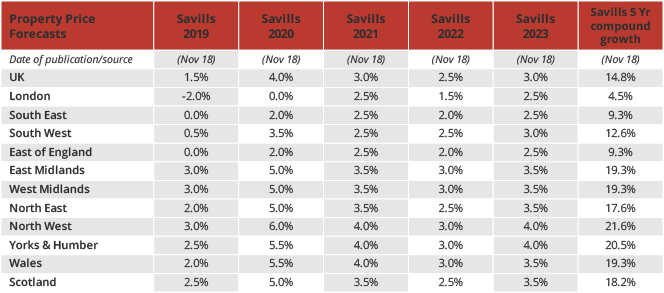
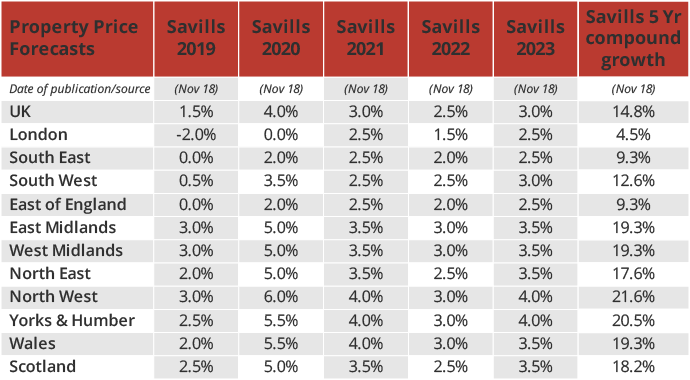
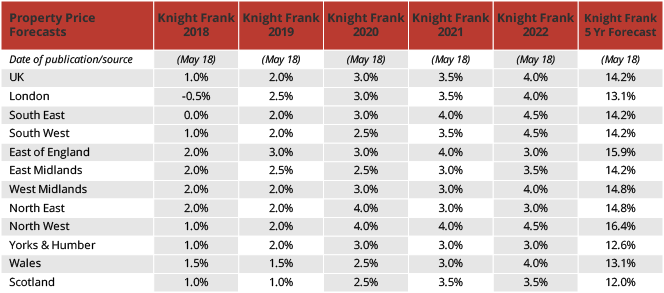
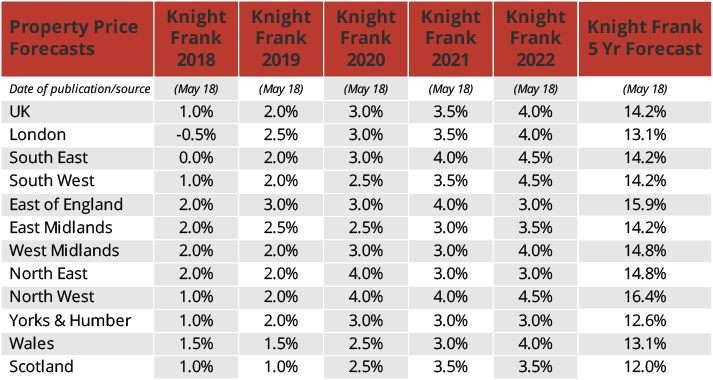
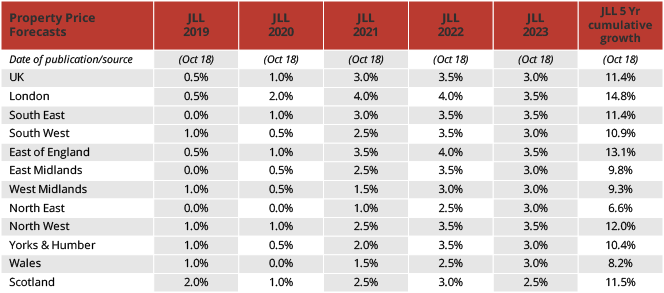
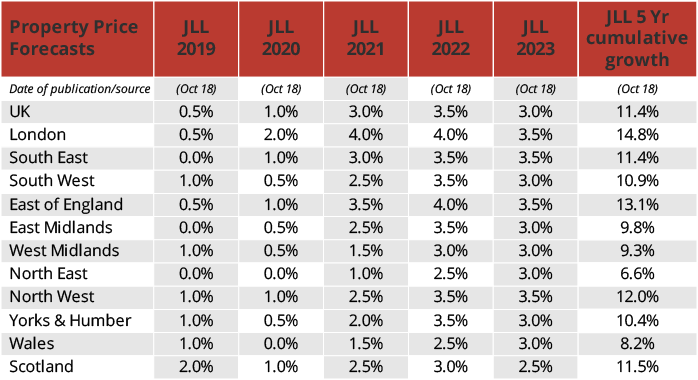
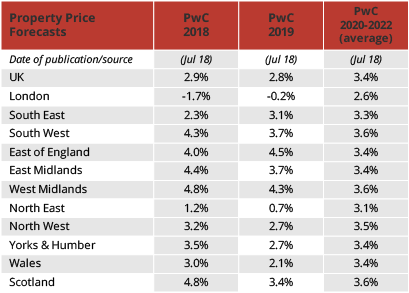
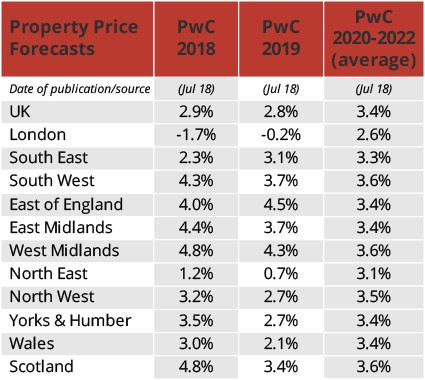
The forecasts show that JJL and Knight Frank are suggesting pretty similar predictions, while Savills are suggesting quite grim growth for London, suggesting prices will grow around 4.5% over the next 5 years. This might seem OK, it’s still growth after all. But Londoners are used to 7-10% annual growth, so if Savills are correct this will dramatically change people’s views on investing in property. This forecast means people would have only a bit of extra equity to trade up, they will then suffer a double whammy of affordability caps due to mortgage regulation changes.
The ‘good news’ though is if Savills forecasts are correct, then regional growth is expected to be good – and I do agree with this, the ‘south’ to me has almost ‘maxed out’ it’s price growth now. In contrast, the lack of price recovery in the regions since the credit crunch suggests there is definitely more growth available.
What people need to be aware of though is that in the regions, property price growth is a lot more varied than ‘down south. So averages don’t reflect what’s really happening, it’s down to individual road and price performance.”
Kate Faulkner @KateFaulkner – Property Market Analyst & Commentator – Designs on Property | Property Checklists | The Buy-to-Let Show (Online TV) | The Property Hour
Founder of The Advisory, Gavin Brazg
 “It goes without saying 2019 is all about Brexit and up until recently (in my capacity of running a trading business that predominantly purchases middle market family homes) it’s not really been a cause for concern. However, in 2019 the business is looking to reduce trading volume and de-risk as much as possible until there is clarity on Brexit.
“It goes without saying 2019 is all about Brexit and up until recently (in my capacity of running a trading business that predominantly purchases middle market family homes) it’s not really been a cause for concern. However, in 2019 the business is looking to reduce trading volume and de-risk as much as possible until there is clarity on Brexit.
Around Sep 17 we noticed something shift. The traditional ‘after summer’ pick up in the market didn’t materialise. Instead, fall throughs went up and buyer enquiries went down, and have stayed down. Uncertainly about our political future is understandably causing all but the most ‘needs-driven’ home movers to put their plans on hold. We can’t see this changing until we get certainty on our Brexit path.
If a deal can be agreed then potentially we’ll all be doing a new dance called ‘The Brexit Bounce’ and we’ll be back to business as usual to some respect. If it’s a no deal / crash out scenario then we’re really into the weeds with yet more uncertainty.
If it wasn’t for the now very real possibility of us facing a No Deal scenario, I’d have said Q1 2019 would be a great time to drive a hard bargain with nervous sellers. However, as the time of writing (Dec 15th 2018), I’m not so sure.
For what’s it’s worth my advice is don’t go making any big bets in 2019. It’s going to be a nail-biting rollercoaster ride.”
Gavin Brazg @AdvisoryUK – Founder of The Advisory and Creator of PropCast
Director of Property Investments UK, Robert Jones
 “We have noticed from on the ground buying and selling our own properties, as well as working with multiple investors across the UK and worldwide, there has been a shift to a buyers market at the end of 2018 in many locations. With investors in this market favouring purchases that deliver yield and cash flow in light of the uncertainty of growth.
“We have noticed from on the ground buying and selling our own properties, as well as working with multiple investors across the UK and worldwide, there has been a shift to a buyers market at the end of 2018 in many locations. With investors in this market favouring purchases that deliver yield and cash flow in light of the uncertainty of growth.
However even with the continuing uncertainty of Brexit, the value of the £ to overseas investors has continued to make the UK very appealing, investor inquiries and overseas investor purchases we are seeing still at a high which we are anticipating will continue through to 2019, even though these investors are continuing the trend and are holding out for high yielding opportunities.
Purpose built student accommodation, serviced accommodation and development opportunities we have noticed a strong movement towards which is likely to continue in 2019 and will likely pick up even further if more lending options become available in this space.
We’ve also seen as an increase in interest and focus specifically on properties where investors can get in and out of quickly as the speed of property transactions becomes more important, which can be achieved with models like property crowdfunding.”
Robert Jones @PropertyUK_ – Director, Property Investments UK
Partner of Stewardson Properties, Phil Stewardson
 “As we head into 2019, uncertainty isn’t easing – Brexit, the economy, government legislation… All this uncertainty leads to a lack in confidence, but the upside is that opportunities will be plentiful for investors who have done their research and have a plan.
“As we head into 2019, uncertainty isn’t easing – Brexit, the economy, government legislation… All this uncertainty leads to a lack in confidence, but the upside is that opportunities will be plentiful for investors who have done their research and have a plan.
2018 was an amazing year for Stewardson Developments & our four group companies with our portfolio’s expanding both in the West Midlands and North West. Acquisitions averaged one property per week across residential, industrial and mixed-use retail. Our strategy has always been to target ‘out of favour’ sectors. And at present, this is retail where – if you get it right – there are great opportunities to add value, achieve great yields and see a big uplift in value. We will continue pushing forward on this strategy into the new year with the mantra: ‘we will buy anything if we can see an angle.’
2019 will continue to see a lot of landlords exit the market, welfare reforms (particularly the debacle that is universal credit), Section 21 and increased regulation have been the final straw for many small-scale landlords, this will provide opportunities for new investors who have done their research into the market fully. I would advise any now though that it is more important than ever to take professional advice on what and how you buy and ensure that your investment is ‘a good fit’ into your strategy, particularly from a tax perspective.”
Philip Stewardson @PhilStewardson – Partner / Director, Stewardson Properties/ Stewardson Developments
Head of BM Solutions, Phil Rickards
 “Buy-to-let lending is increasingly geared towards remortgage business which is in line with our expectations.
“Buy-to-let lending is increasingly geared towards remortgage business which is in line with our expectations.
There has been much talk in the industry that we could a see a further decline in the buy-to-let purchase market as a result of landlords potentially leaving the market or restructuring portfolios in order to remain profitable. Although we are not seeing any immediate evidence of this, tax returns due in the 2019 are sure to see some landlords feeling the pinch of the reduction in mortgage interest relief – so this will be one to keep a close eye on.
For those landlords who are purchasing, we are seeing a slight shift in lending to limited companies which could be directly as a result of recent the tax changes.
The remortgage market is expected to grow driven by increased maturities and this is supported by an increasing number of lenders now offering product transfers for customers who want to remain with their existing lender. Investors remaining within the market are expected to be increasingly price sensitive and the market has become incredibly competitive which is good news for landlords.
We are also seeing increasing numbers of landlords fixing mortgages over the longer term (five years or more) as they look for certainty and more favourable lending decisions as a result of lower stress rates.
The market has performed broadly in line with expectations this year and we are expecting it to remain stable over 2019, although it’s currently unclear given wider uncertainty around the future of the UK.
And for the mortgage market in general, it’s also good news to have clarity around Help to Buy. This is likely to have a positive impact on the new build sector for the next four or five years, which is an optimistic way to end the year.”
Phil Rickards – Head of Sales, Birmingham Midshires (BMS)
Managing Director of Keys Mortgages, Lisa Orme
 “It’s a fantastic time to be a specialist mortgage adviser as that is the area of the market that has opened up the most in recent years. Rates are still incredibly and historically low but lenders can only tweak rates and fees so much to attract new business. Where we are seeing the biggest changes is in criteria.
“It’s a fantastic time to be a specialist mortgage adviser as that is the area of the market that has opened up the most in recent years. Rates are still incredibly and historically low but lenders can only tweak rates and fees so much to attract new business. Where we are seeing the biggest changes is in criteria.
Lenders are really looking at the under-served portions of the market and how they can offer products that win them that business. For specialist brokers such as ourselves, this is manna from heaven! No longer is it a case of looking at the cheapest deal but it’s understanding each lenders’ particular (and sometimes peculiar!) criteria and nuances; something we have always done and love. Not only great for us but also great for clients who previously thought of themselves as mortgage pariahs, mortgage prisoners or victims of higher rates and fees. We are seeing some extremely complex and unusual incomes, company and employment structures and the likes of contractors, the self-employed, those who receive multiple sources of income and full-time landlords are now seen as the norm by many lenders.
In buy to let too the market is starting to polarise into two distinct sectors. The new and small-scale landlord typically has a good income in the background and meets most lender’s criteria and thus attract the best rates and fees. Looking at 5-year fixes that begin with a 1 as I did today is pretty amazing for what is in effect a commercial loan! At the opposite end of the scale, the professional and often full-time landlord has emerged in much greater numbers. Now opting for company structures, HMOs, commercial and semi-commercial and multi-units to counteract the effects of mortgage tax relief and stamp duty changes as well as greater costs due to tighter regulations such as HMO licensing. Only a couple of years ago lenders in this space could be counted upon one hand but now we have a myriad of options. Again lenders can only go so far on pricing so we are seeing all sorts of criteria changes and flexibility, opening up the market to more and more borrowers almost daily.
We have concerns around Brexit, the long-term interest rate environment as well as overseas and domestic policies but these types of external factors will always be there in one form or another. The fact is there is currently a very active and competitive mortgage market out there and now is most definitely the time to capitalise on that.”
Lisa Orme @LisaOrme – Specialist Advisor and Managing Director, Keys Mortgages
Sales and Marketing Director of OneSavings Bank, John Eastgate
 “The state of the housing market reflects the level of consumer confidence, and right now, it’s negative and getting worse, which can hardly come as a surprise given the inability of our elected leaders to separate personal agendas from public responsibility and achieve an orderly Brexit. With disorder looking like it will reign supreme into at least January, the market outlook is at best subdued and if we end up with a no deal Brexit, then there will arguably be bigger issues than house prices to deal with. Uncertainty might well be perpetuated even further into 2019, not least if rising calls for a second referendum gain parliamentary traction, as it appears they might. Of course, if our Prime Minister can pull a lapin from the European chapeau, then we might well see confidence – and the housing market – stabilise.
“The state of the housing market reflects the level of consumer confidence, and right now, it’s negative and getting worse, which can hardly come as a surprise given the inability of our elected leaders to separate personal agendas from public responsibility and achieve an orderly Brexit. With disorder looking like it will reign supreme into at least January, the market outlook is at best subdued and if we end up with a no deal Brexit, then there will arguably be bigger issues than house prices to deal with. Uncertainty might well be perpetuated even further into 2019, not least if rising calls for a second referendum gain parliamentary traction, as it appears they might. Of course, if our Prime Minister can pull a lapin from the European chapeau, then we might well see confidence – and the housing market – stabilise.
Markets need willing sellers and willing buyers however in the absence of confidence, consumers avoid risk and choose the ‘do nothing’, suggesting that there will be an absence of both. That will see the purchase market particularly challenged, leaving lenders with an increased dependency on re-mortgage business. As well as chasing a limited pool of purchasers, lenders will home in on the retention of existing borrowers, who can expect some [relatively] good retention products to be available, either direct from lenders, or, increasingly, through lenders working with brokers. If the recent reduction in long-term swap rates flows through into actual borrowing rates, then all borrowers might benefit from an extended period of very competitive long-term fixes.
In 2018 we saw landlord’s finances squeezed by tax changes, and as of early next year, this will be exacerbated as the tax changes bite that bit harder; landlords will notice on their January tax bills the 50% mortgage interest tax relief reduction, and as of April, this will climb to 75%. This will continue to dampen new purchase activity, especially from small-scale or highly leveraged investors. Many professional landlords have already created limited companies and moved their portfolios into this in order to protect themselves as much as possible from the tax changes, and we expect that as the tax changes bite even harder, there will still be solid demand for limited company loans from professional investors. The tax changes heighten the importance of yield for landlords, with many professional landlords already looking further afield to access higher yields, and some diversifying into HMO, commercial and semi-commercial property. It’s likely we’ll see elements of this behaviour next year as well. Notwithstanding the reality that the UK’s economic and political outlook is at its most unpredictable for decades, professional investors, looking at the long-term, will continue to see the attractiveness of the sector, which will continue to fulfil an essential part of the UK’s housing landscape.”
John Eastgate @KentReliance – Sales and Marketing Director, OneSavings Bank and Kent Reliance
Director of the Buy-to-Let Broker, Matthew Rowne
 “The Buy to Let Broker was fortunate enough to enjoy yet another record year in 2018, and the outlook for next year remains more than positive.
“The Buy to Let Broker was fortunate enough to enjoy yet another record year in 2018, and the outlook for next year remains more than positive.
That being said, to forecast the property market in 2019 is, I believe, a close to impossible task. I think most people would agree that we are very much in a time where there is large economic uncertainty, making forecasting particularly jeopardous.
Even though the UK may now be entering a period of interest rate rises, it should all be considered within context, and we expect rates to remain low over the short to medium term compared to long-term norms.
Focussing my opinion on the Buy to Let market, landlords have had a challenging few years where the committed investor has had to adapt with the constant shifting sands of regulation and changing tax rules. It is undoubtable that Buy to Let is more challenging now, than at any time in the last two decades.
With the ripples of impact still being felt from lenders tightened affordability/underwriting criteria from the Prudential Regulation Authority guidelines introduced at the beginning of 2017, and the tax relief changes still within the four-year transition period, landlords, brokers, and lenders, have had a lot to consider. Indeed 2019 will potentially be the year where many landlords first feel the impact of Section 24.
However, from a Buy to Let perspective, regardless of the long term conclusion to Brexit, economic uncertainty has in some ways underpinned the market, and should not necessarily be seen as a negative. Indeed, seeing the trends first hand, and speaking with investors, it is abundantly apparent that 2019 will be another strong year for the sector.
Firstly, whilst the full effects of section 24 may not be felt until the rules fully implement in 2020, now is most definitely the time for landlords whom have not already done so, to review their position, and ensure that they have a robust strategy moving forward. With many landlords only feeling the pinch when they submit their tax returns, possibly as late as January 2019, we expect the second wave of professional landlords seeking specialist, professional advice. This will be especially true in respect of landlords contemplating the benefits of incorporation, and the complexities that surround such transactions.
Rather than see committed investors exit the market, we expect to see landlords continue to innovate and adapt, and with rental coverage requirements more difficult to meet in areas with high property prices, many landlords will potentially look towards multi-lets and HMO’s, and with some of the more savvy investors looking for new areas to invest, balancing the location of their investments. The North has continued to be a viable alternative for many investors, with the higher yields both increasing leverage opportunities, and enabling landlords to tackle head on some of the diminishing returns caused by the recent changes.
Secondly we are buoyed by the continued innovation in the sector. Existing lenders are coming out with exciting products and attractive criteria, helping brokers and landlords to successfully navigate the changes, whilst new lenders continue to come to prominence in the market. We see this continuing, possibly even accelerating, through 2019. However it is critical that lenders and brokers continue to keep pace with this evolution, to avoid the risk of losing this considerable opportunity.
One such innovation is within the short term lettings market, an area where we are seeing more and more lenders ‘dipping their toe’ in this particular specialist area of the market. This in turn gives landlords, and brokers more options than ever before. Indeed some early research from RLA found that of those landlords now offering short-term lets, over 1 in 3 were doing so because of tax increases on landlords, as the reduction in tax relief available on mortgage interest does not currently apply to those renting properties as short-term lets.
Finally, with the various socioeconomic pressures, the reality is that private landlords are more in demand than ever before. Overall homeownership has been declining in favour of private renting since the early 2000’s, and private renting has rocketed, (effectively doubling since 2002). Technology continues to change the way that people live and work, with employees no longer forced to live close to a place of work. This will likely have an impact on the whole property market, as people move away from the cost of city living, spreading into areas which have not been the traditional domain of the PRS. One thing is for sure, renting is here to stay, and those who succeed in property investment are landlords that invest in their tenants, and have the foresight to invest in new opportunities.
In light of the above, it is important that it is recognised that the landlord is not the public enemy that some avenues of the media would want people to believe. In fact, from a socioeconomic perspective, I would strongly argue the opposite. Total turnover in the residential lettings sector in England and Wales is estimated at over £4 billion and it employs nearly 60,000 workers, paying out around £5 billion in wages, and paying a total of £5 billion in taxes. Not a bad contribution at all!!
Add to this that the private rented sector remains a key housing solution for many homeless people, given the supply of social housing is nowhere near the levels needed to meet demand, we should all step up and show pride in an industry that has a lot to be proud of.
Importantly specialist brokers have risen to the challenge in 2018, and we believe that the calibre of advice and client service being offered across the sector at the moment is more comprehensive than ever before. Landlords need guidance more than ever, and The Buy to Let Broker intend to remain at the forefront of this revolution through the year ahead, helping clients, through robust advice, to remain successful despite the challenges.
Instead of seeing this as a period of gloom, there are a myriad of positives out there, and with landlords becoming more professional, in our opinion, the industry has a lot to look forward to in 2019.”
Matthew Rowne @BuytoLetBroker – Director at The Buy to Let Broker
Associate Director of L&C Mortgages, David Hollingworth
 “There’s one major issue on the horizon that doesn’t help when it comes to forecasting what the New Year could bring for the market. Brexit brings so much uncertainty that it will be of little surprise if the slowing in purchase activity we’ve seen at the back end of this year continues into 2019.
“There’s one major issue on the horizon that doesn’t help when it comes to forecasting what the New Year could bring for the market. Brexit brings so much uncertainty that it will be of little surprise if the slowing in purchase activity we’ve seen at the back end of this year continues into 2019.
Many consumers will be taking a wait and see approach when it comes to buying and selling and that will put a drag on activity levels in the first quarter at least. The rate of improvement in activity levels will, of course, depend to a large degree on how quickly that uncertainty is removed.
However, the lack of availability of homes on the market and the rate of supply of new homes is likely to support prices to a degree. Despite the regional variation that is such a feature of the market now, prices are likely to be pretty flat.
Brexit could clearly have implications for interest rates as well and any further weakening in the pound could push up inflation. Although higher inflation would typically signal rising interest rates, the Bank of England has already shown that it’s prepared to cut rates if it feels the economy needs support, so we could see a rate cut just as we did following the referendum.
Mortgage rates remain extremely low and competition between lenders is likely to be fierce next year. That will offer borrowers the opportunity to take advantage of attractive mortgage deals whether they are pushing ahead with a new purchase, investing in property or simply protecting themselves against uncertainty.”
David Hollingworth @LandC – Associate Director, L&C Mortgages
Founders of BrickVest, Emmanuel Lumineau and Thomas Schneider

 “We are living challenging times for the real estate market.
“We are living challenging times for the real estate market.
It seems like that yield compression reached its peak but there is no signs yet for significant price corrections either. The market remains positive but acts very careful – no one wants to be caught by a quick and significant price correction within the real estate market.
Focus remains on income producing assets since proper value-add opportunities are harder and harder to get or risk/return profiles are not fairly distributed.
We can see more and more real estate investors positioning themselves to make significant bargains in case of a hard Brexit.”
Emmanuel Lumineau and Thomas Schneider @BrickVest – Founders of BrickVest
Founder of The House Crowd, Frazer Fearnhead
 “In 2019, we should expect to see a continued narrowing of the North-South property divide. In my view, the market in the North West, particularly in Manchester, benefit the most. There are a few reasons for this, not least because the North West has so much to offer all generations and types of homebuyers.
“In 2019, we should expect to see a continued narrowing of the North-South property divide. In my view, the market in the North West, particularly in Manchester, benefit the most. There are a few reasons for this, not least because the North West has so much to offer all generations and types of homebuyers.
In part thanks to the government’s ‘Northern Powerhouse’ campaign, Manchester has become an ideal city for businesses to set up in – even Amazon has agreed to take 100,000sq.ft. for a new R&D hub employing 600 staff. This, of course, also acts as a boost for the nearby cities and towns in the North West.
Furthermore, there has been large-scale regeneration in various parts of the North West over the last four years and the results are paying off – it’s become a very desirable place to live. As a result, the property market is vibrant in the region – especially by comparison to London, which is currently experiencing a slump. And, as demand increases, so too does the amount of property development in the area. For example, The House Crowd is currently crowdfunding a £15 million housing development in Altrincham, Greater Manchester.
I truly believe that Manchester will continue to be a trendsetter in the property development market for 2019.”
Frazer Fearnhead @FrazerFearn @TheHouseCrowd – Founder, The House Crowd
Co-Founder of Crowdlords, Richard Bush
 “My prediction for property crowdfunding in 2019 is a continuation, or indeed an acceleration, of some of the changes we have witnessed this year. They have more to do with ours being a maturing market segment than the environmental issues that we’ll all face as a result of Brexit and they can be summed up by four C’s – Consolidation, Collaboration, Convergence and Corporatisation (is that really a word?!).
“My prediction for property crowdfunding in 2019 is a continuation, or indeed an acceleration, of some of the changes we have witnessed this year. They have more to do with ours being a maturing market segment than the environmental issues that we’ll all face as a result of Brexit and they can be summed up by four C’s – Consolidation, Collaboration, Convergence and Corporatisation (is that really a word?!).
The number of new platforms launched each year is reducing, but the number of platforms closing is increasing – as ‘copycat’ businesses realise that this is not the license to print money that they thought it would be. As a result of the significant infrastructure costs involved in running an effective platform, I predict that in 2019 we will see a number of platforms consolidating either through mergers or acquisitions.
Whilst that consolidation will be attractive to some platforms, other operators will look to achieve the same improvements in efficiency through collaboration. Sharing ideas, platforms and resources and working together to achieve the engagement and education of a wider audience needed for this to become a sustainable service.
Partly because of these two trends and partly as a result of trial and error, I also expect to see a convergence of the propositions and the business models employed behind those propositions. The winners will be those who unwaveringly focus on the quality of the product and the levels of service provided. There will be some outliers who look to try new things, but after nearly 5 years in business, we now know what works and what doesn’t work.
Finally, now that some of the early platforms have proved that the business model works and that Property Crowdfunding is here to stay I think we’ll see some of the more innovative corporations looking to acquire a platform for themselves. They may be lenders, banks, large developers, asset managers or wealth management business, all of which have the potential to generate more value or to differentiate their service by adding a property investment platform to their existing services.
So more change and many new opportunities, all part of the natural evolution of our segment. And quite rightly, the people best placed to benefit will be the ever-expanding cadre of investors. Roll-on 2019!”
Richard Bush @CrowdlordsRich @CrowdLordsLtd – Co-Founder, Crowdlords
Co-Founder of Simple Crowdfunding, Atuksha Poonwassie
 “This year, the property industry has embraced change and we have seen alternative finance options being increasingly utilised. With the market conditions changing due to the uncertainty of factors such as Brexit, property developers and professionals will need to explore more avenues for raising capital. I am expecting to see the more traditional lenders provide new offerings and the availability of alternative finance options increase.
“This year, the property industry has embraced change and we have seen alternative finance options being increasingly utilised. With the market conditions changing due to the uncertainty of factors such as Brexit, property developers and professionals will need to explore more avenues for raising capital. I am expecting to see the more traditional lenders provide new offerings and the availability of alternative finance options increase.
The recent ‘5th Alternative Finance Industry Report 2018’ published by the Cambridge Centre for Alternative Finance showed significant growth in the alternative finance market overall in 2017. The total size and growth of the overall market represents an annual growth of 35.2% to £6.19 billion. Of this, the peer-to-peer property lending market grew by 6% to £1.22 billion, suggesting stabilisation in the market. Real estate crowdfunding grew by 197% from the previous year, driving £211 million in total.
Over the next 12 months, I expect to see this upward trend in property financing to continue, whilst growing at a slower pace. Real estate focussed property crowdfunders have come and gone and I expect there to be further consolidation over the coming months and years. Peer-to-peer for property will continue to grow with simple enhancements; an increase in auto-selection and more institutional funds being accessible. The uptake of the Innovative Finance ISA is also picking up pace and I expect this to be a significant growth area in 2019.
For those raising finance, more information will need to be provided regarding alternative exit strategies and associated financials. However, the outlook is good for those looking to raise finance in the property sector.
This also presents an opportunity for Investors. I expect that the Simple Crowdfunding ‘Learn Whilst Investing’ program where investors invest and learn from property developers throughout the project lifetime will become more popular. Having spoken to many investors in the community, this allows them to invest in areas that interest them such as commercial to residential or new builds and learn from property professionals who are already active in this area. It also allows them to invest smaller amounts into multiple projects, to better spread their risk.”
Atuksha Poonwassie @Atuksha @SimpleCrowd – Co-Founder, Simple Crowdfunding
Head of Research at Property Partner, Mark Weedon
 “The UK housing market has experienced below average growth in 2018. Brexit-related uncertainty has dissuaded some foreign buyers, compounding the government’s sustained crackdown on buy-to-let investors, while housing remains unaffordable for some would be buyers.
“The UK housing market has experienced below average growth in 2018. Brexit-related uncertainty has dissuaded some foreign buyers, compounding the government’s sustained crackdown on buy-to-let investors, while housing remains unaffordable for some would be buyers.
Nevertheless, in spite of the well documented cooling of the London market, the broader picture is of continued growth and stability, in the face of wider market uncertainty, with significant regional variation. Indeed, the ONS UK HPI shows UK house prices increased on average by 2.7% in the 12 months to the end of October, above other prices in the economy, with CPI inflation up by 2.4% over the period. By the same token, overall transactions in the 12 months to the end of October numbered 1.19m, just -2.1% lower than the equivalent period one year ago and very much in line with the last 5 year trend.
Property Partner’s own marketplace has broadly mirrored the wider market, with investors demonstrating greater appetite for residential blocks in the midlands and North, as well as high yielding Purpose Built Student Accommodation. By contrast, demand for low yielding London properties has reduced markedly, with such assets typically trading at discounts to underlying asset value on our Resale Market. With a smaller number of buyers now holding the whip hand, they’ve been able to price in uncertainty and secure attractive deals on investments in the capital.
Our expectations are for more of the same next year, at least until the Brexit impasse is resolved and some clarity returns as to what the future holds for the UK’s relationship with the EU. In the meantime we see the UK residential market as a land of opportunity for patient investors who are able to move quickly and buy in cash, taking advantage of sellers who need to extract capital and accept lower prices.
As unlikely as it may seem given the current deadlock in the House of Commons, a sudden happy ending to Brexit could provide a positive bounce for the market, but we view it as prudent to plan for further uncertainty and market cooling, adopting a firmly opportunistic approach to our Q1 2019 investment strategy.
Ultimately, the fundamentals of the UK housing market have not changed since the EU Referendum and will not change in 2019. A shortage of supply of good quality accommodation across tenure types, in the face of growing demand for housing, will continue to support house price growth in the medium to long term.
Similarly, the 80% of dwellings held by owner occupiers (63%) and social landlords (17%) don’t trade like a commodity and are likely to continue to demonstrate a stickiness to their pricing, in the face of cooling investor market sentiment. Consensus forecasts that interest rates will remain low for the long term will also help ensure affordability among a sufficiently large pool of potential buyers to keep the market ticking over.
Ultimately, UK property still represents a resilient, income producing investment, not subject to the short term sentiment-based volatility of the stock market and other asset classes. We believe that UK property investments completed in 2019 will continue to deliver the strong performance over the next 5 to 10 years, which investors have become accustomed to over the previous 20.”
Mark Weedon @Prop_Partner – Head of Research, Property Partner
Founder and Chief Executive at The Buy to Let Business, Ying Tan
 “It’s clear, following the focus on the lettings industry by the government in 2018, that in the twelve months ahead regulation will be the topic du jour.
“It’s clear, following the focus on the lettings industry by the government in 2018, that in the twelve months ahead regulation will be the topic du jour.
From the debate surrounding longer tenancies to the Tenant Fees Bill, there is a clear focus on the safety and security of renters and I think that will continue in 2019. I understand why landlords may be concerned about tightening regulations and a crackdown on lettings agents, however, I actually think all of this can only be a positive thing. Along with the fact we all want to ensure the rental market is safe and fit for purpose for those who use it, the fact that the sector is under the spotlight demonstrates the government’s realisation (finally!) that the rental market is an essential part of the housing market and should be treated as such.
Lenders will need to respond to any changes, particularly surrounding longer tenancies (if such a policy ever comes about), but I think they have shown over the past few years that they are willing and able to do just that so I think we can look forward to a positive year for the sector.”
Ying Tan @TheBTLBusiness – Founder and Chief Executive, The Buy to Let Business
Business Development Manager at Optimise Accountants, Simon Misiewicz
 “We all need to remember that the UK population is increasing and that the size of UK land is not, to my knowledge anyway. In addition, there are many people that cannot afford/do not want to buy their own properties, despite what the government may be suggesting. There will be a requirement of rental properties to be made available for the growing population that want their own space from parents/guardians.
“We all need to remember that the UK population is increasing and that the size of UK land is not, to my knowledge anyway. In addition, there are many people that cannot afford/do not want to buy their own properties, despite what the government may be suggesting. There will be a requirement of rental properties to be made available for the growing population that want their own space from parents/guardians.
As many of the commentators have already suggested that Brexit will be a major buying consideration when purchasing a home or buy to let property. I have found that risk and fear prevent people from taking action, in this I mean buying a house.
There will be a significant decrease in the so-called accidental/amateur landlord but with this comes a new breed of professional property investors. There will be fewer individuals owning property in the future and replaced with institutionalised structures.
There are many tax changes such as the 3% SDLT surcharge, Section 24 and the removal of the 10% wear & tear allowance. However, a lot of these tax changes will only see an increase in rents that are being charged to tenants. I for one have already increased the rents by 20% over the last 24 months.
Optimise Accountants, have seen a six-fold increase in the number of limited company formations. This is either to act as a buy to hold investment company or act as a property development company. We have also seen an increased focus on holiday lets/serviced accommodation. Another emerging strategy is to buy commercial properties and convert them into residential properties to avoid the 3% SDLT surcharge, whilst keeping the residential properties held within a limited company structure. The main reason for the strategic changes is to mitigate the impact of Section 24 mortgage interest relief cap that would affect their personal tax position.
One thing is for certain is that there are significant changes in tax/legislation and people will need to adapt their investments structures in order to make money.”
Simon Misiewicz @Optimise_Tax – Business Development Manager, Optimise Accountants
Spokesperson for Just Landlords, Rose Jinks
 “We’re expecting 2019 to be quite a mixed year for the property market, with the uncertainty caused by Brexit continuing to hit activity across the industry, alongside further changes to the private rental sector, which could switch things up for the better, or worse.
“We’re expecting 2019 to be quite a mixed year for the property market, with the uncertainty caused by Brexit continuing to hit activity across the industry, alongside further changes to the private rental sector, which could switch things up for the better, or worse.
During 2018, we’ve seen many first time buyers being helped onto the property ladder by the Government’s Stamp Duty relief, which we hope will carry on next year. Nevertheless, under the Government’s proposed changes – such as the tenant fees ban – the private rental sector should be a better place to live for tenants in 2019, but industry experts fear that things will only get worse for those stuck in renting.
At Just Landlords, we believe that tenancy deposits will be the big scandal of 2019, as the PPI deadline looms and claims companies start chasing the next
thing. Many tenants may find that they’re entitled to a lot of money if their landlord didn’t adequately protect their deposit, so we may start to see more claims being made. We recently uncovered a worryingly low level of awareness surrounding tenancy deposit law.
Not only must landlords ensure that they understand all of their legal responsibilities, we also urge them to make sure that their taxes are in order before the next phase of the mortgage interest tax relief changes comes into force next year.”
Rose Jinks @JustLandlords – Spokesperson, Just Landlords
Property Investor and Developer, Alan Frost
 “If 2018 looked uncertain, then recent events have made 2019 anyone’s guess!
“If 2018 looked uncertain, then recent events have made 2019 anyone’s guess!
The big issue to the forefront of most people’s mind is Brexit, and the Governor of the Bank of England certainly caught a few headlines with his warnings of big drops in house prices as a result of a no-deal scenario.
Affordability will be the main driver to the sales and rental market in 2019 – domestic buyers in London and the South will continue to struggle, completed sales will dry up and even the panacea of Help to Buy will start to wear out. Buyers were already keeping their powder dry, and Carney’s words will have exacerbated things further. We might see down-sizers finally selling as the top of the market has probably already been and gone.
In the Midlands and increasingly in the North West, great value can still be achieved on both the buying, developing, renting and selling of property, so expect to see more positive news from places like Manchester, Liverpool and Leeds, which will not be as hard hit by any upheaval or uncertainty as London.
In terms of strategies, building a profitable portfolio of both single dwellings or HMOs seems to be getting harder, while serviced accommodation in the right areas will bring great returns. Until other assets become more desirable (maybe after a shock to the property market) land and property prices will still be high, and yields continue to be squeezed. Foreign investors and developers will have competitive edges with the drops in the pound, so investors and developers will have to work very hard to find profitable opportunities, but when they do they should be well worth the effort.”
Alan Frost – Business Development & Acquisitions Manager at Valet Apartments – Corporate Lets Specialist in Central London
Co-Founder of Property Tribes, Vanessa Warwick
 “Once again, it is very hard to predict what may happen in the property market in 2019! The early part of the year will likely be a hang-over from 2018 as uncertainty over Brexit has put a dampener on property transactions and general confidence and positive sentiment about the market. Once people start to realise that life will go on after Brexit, then some form of normality should start to return.
“Once again, it is very hard to predict what may happen in the property market in 2019! The early part of the year will likely be a hang-over from 2018 as uncertainty over Brexit has put a dampener on property transactions and general confidence and positive sentiment about the market. Once people start to realise that life will go on after Brexit, then some form of normality should start to return.
At Property Tribes we are celebrating our 10th anniversary, since our forum was founded in February 2009. So much has changed over those ten years! The PRS has become a roller-coaster ride and many landlords are struggling to stay on board, some clinging on with their fingertips due to increased taxation, legislation, and regulation.
This is why, throughout 2019, Property Tribes will be championing the concept of the ‘Smart Landlord’.
Like smartphones, smart meters, and smart highways, smart landlords are those who are efficient, pro-active, and adaptable to the market conditions. Property Tribes will be producing a wide range of educational content to help create smart landlords.
So I guess one thing I feel confident that I can predict is that it is the educated, engaged, and informed landlord who totally immerses themselves in their business who will be the ones who survive and thrive, and even see opportunity amidst all the doom and gloom.
Property Tribes hopes to support them through 2019 and beyond, as the private rented sector is still very much needed, despite being so maligned by the media and anti-landlord bodies, one thing that will surely continue into the new year. Ethical/decent landlords will stick to their guns and quietly get on with their business, working that little bit smarter in order to stay in the game and continue towards their long-term property goals. Property Tribes will be with them every step of the way”
Vanessa Warwick @4_Walls – Co-Founder of Property Tribes
CEO and Editor-in-Chief of Property Forum, Nicholas Wallwork
 “Prospects for the UK housing market in 2019: It is fair to say that 2018 has been an eventful year in the UK both in terms of politics and the property market. While Brexit has grabbed the headlines, investors with a long-term strategy have been waiting patiently on the sidelines to cherry pick the best bargains. The reality is that Brexit has created some very interesting opportunities for those able to see beyond the current confusion.
“Prospects for the UK housing market in 2019: It is fair to say that 2018 has been an eventful year in the UK both in terms of politics and the property market. While Brexit has grabbed the headlines, investors with a long-term strategy have been waiting patiently on the sidelines to cherry pick the best bargains. The reality is that Brexit has created some very interesting opportunities for those able to see beyond the current confusion.
Clarity on the way: Here at Property Forum we have access to a wide range of opinions from members scattered all over the world. The general consensus seems to be that Brexit will be resolved one way or another in the short term with many expecting a return to the European fold. In the meantime, there are still positive aspects to the UK housing market which will ensure that there are no short sharp shocks.
Strong rental yields: Even though there are schemes supported by the government to assist first-time buyers there is still extremely strong demand for private rental accommodation. A lack of social housing, together with more words than action from the government on this front, will ensure that demand for private rental properties remains intact. The average rental yield now stands at around 4% although selective buying and investment in HMOs can yield double-digit returns. Contrary to popular belief, immigration will continue to feed the private rental market together with domestic demand.
Low cost of finance: Just a few months ago it looked as though the Bank of England was about to adopt a policy of gradually increasing interest rates. This policy appears to have been put on hold, resulting in an extended period of relatively low-cost finance. Concerns regarding a significant boost in inflation, due to weaker sterling, would appear to have been overdone at this juncture. Therefore, all of the signs suggest that low-cost finance will continue for some time to come in the UK.
UK investors locked into UK housing: Sterling has seen a circa 20% reduction in its value against the euro and the dollar in recent years. While many have quite rightly identified this as a positive for overseas investors looking towards UK housing, it does have an impact on UK investors looking overseas. The reduction in the sterling exchange rate has seen a significant increase in the cost of overseas property. Amid suggestions that Brexit could be cancelled, and sterling undertakes at least a partial recovery, the majority of UK based investors will likely continue to focus on UK housing for now.
Overseas investors increasing exposure: Under the radar, overseas investors have been slowly increasing their UK housing exposure and as we receive more clarity regarding Brexit this will strengthen. If, as expected, there is a second referendum in favour of Remain this would reduce any downward pressure on sterling. Therefore, it is safe to say that many overseas property investors are waiting to pull the trigger on UK investments.
UK house prices: While average UK house prices are likely to remain relatively ‘soft’ ahead of a definitive decision on Brexit, we don’t foresee any sharp fall in house prices. Sellers are still reluctant to list their homes although some buyers are beginning to cherry pick the better opportunities available. As a consequence, we don’t expect a race to the bottom, no panic selling with the market supported by a firm backbone of demand and cheap finance. There may be further downside in London property prices in the short term but a reversal of the first Brexit referendum would see a sea change in sentiment towards the capital. Write London off at your peril!
The likes of Manchester, Leeds and Birmingham continue to see significant house price growth, expanding business communities and many high profile relocations such as HMRC and Channel 4. Significant investment in infrastructure and the redevelopment of city centres together with various opportunities in the student accommodation market have not gone unnoticed. While much of this is currently occurring under the ‘mist of Brexit’ there are plenty of reasons to be optimistic about the UK housing market in 2019.”
Nicholas Wallwark @Nick_Wallwork – CEO and Editor-in-Chief of Property Forum
Sales Director at Mortgages for Business, Jeni Browne
 “Whilst Brexit is of course a concern, this country continues to have a shortage of housing so I believe that buy to let property will remain a good long-term investment. However, we will continue to see a fall the number of investors who use buy to let as an alternative pension plan.
“Whilst Brexit is of course a concern, this country continues to have a shortage of housing so I believe that buy to let property will remain a good long-term investment. However, we will continue to see a fall the number of investors who use buy to let as an alternative pension plan.
Now is the time of the full-time landlord who operates a more focused and larger-scale investment strategy born out of the recent fiscal and regulatory changes. For these landlords borrowing via a limited company has become the norm. We expect them to diversify their portfolios with HMOs, multi-units, mixed-use and even commercial property.
So step forward the specialist lenders who have the processes and capabilities to underwrite these more complex mortgage applications. And step forward too, the specialist brokers who have the expertise and relationships, and crucially, the direct access to get these deals placed and over the line.”
Jeni Browne @MortgagesforBus – Managing Director, Mortgages for Business
Director at Coreco, Andrew Montlake
 “The big issues clouding everything next year is the dreaded B-word, which makes any kind of prediction at all fraught with danger.
“The big issues clouding everything next year is the dreaded B-word, which makes any kind of prediction at all fraught with danger.
As far as interest rates are concerned, if things go relatively smoothly, the gentle pace of interest rate rises should continue with a couple of 0.25% rises over the next 12 months. The Bank of England will not want to deviate from this course of action unless circumstances dictate otherwise and despite all the tough rhetoric from Carney, this would probably be the perfect scenario going forward.
As far as house prices are concerned, again there is much disparity over what would happen in the event of a deal, no deal or even a change in colour of the Government itself. The problem with all the political in-fighting is that it causes the one thing that every market hates: uncertainty.
It would seem that we are set for a flat year where prices are concerned with growth overall around the 1% – 2% level, but there will continue to be major fluctuations in this figure depending on location.
We have already seen property prices fall in London and the South East, although we are now seeing renewed interest in Central London from those thinking that now is the time to get a good deal. There are already voices proclaiming the bottom of the market in London.
Overseas buyers may be encouraged by the weakness in the pound and if there is soft Brexit we could see property prices bounce back. How Europe reacts itself to Brexit could encourage others to invest in a relatively stable UK market where there are deals to be done. Our political issues are nothing compared to many other countries.
The real change would be an end to uncertainty which has stopped many people making any kind of move. Once people know exactly what situation they face decisions can be made.
As far as mortgages are concerned this is set to be another ultra-competitive year as lenders battle for business. New lenders have come into the market and are starting to try to flex their muscles so expect rates to stay low and lenders criteria to ease further as they look to develop new markets.
Remortgages will continue their dominance, whilst first-time Buyers will continue to grow at the expense of amateur buy-to-let landlords.
It’s going to be a tough year, but ultimately rewarding for those prepared to seek out a deal and put in some hard work.”
Andrew Montlake @MontysBlog @Coreco – Director at Coreco (London Mortgage Brokerage) | Monty’s Mortgage Blog
Director at Searchlight Finance, Simon Allen
 “Last year, my predictions all came true which is great news for landlords and investors. More lenders equals better rates and criteria which benefits all. In 2019 I see even more lenders coming into an overcrowded market and for them to survive they need to enter areas which are undersupplied e.g. holiday lets, serviced accommodation, refurbishment finance, portfolio loans. The remortgage market is huge and we are already seeing free legals and free/discounted valuations for limited companies. These need to be the norm not the exception.
“Last year, my predictions all came true which is great news for landlords and investors. More lenders equals better rates and criteria which benefits all. In 2019 I see even more lenders coming into an overcrowded market and for them to survive they need to enter areas which are undersupplied e.g. holiday lets, serviced accommodation, refurbishment finance, portfolio loans. The remortgage market is huge and we are already seeing free legals and free/discounted valuations for limited companies. These need to be the norm not the exception.
We all want better service and technology. Holding on for an hour to a lender to get an update or waiting 10 days to review an email is not ideal for anyone and we all lose when this happens. Some lenders are excellent as we now have electronic signing of documents and turnaround times of 2-4 days and I want more of that for you.
I do see some bad news this year in the bridging sector. Again, there are too many lenders and two who I expected to fail in 2018 have done. I can see more of it as they run out of money as the people who control the finance pull out of the sector. It’s important that you use a reputable broker who understands the market and knows the lenders to avoid. The good news is that the size of this sector is down to the lack of banks who do bridging. I’ve been told that at least one major bank will be doing bridging in 2019 which is good news for everyone.
Political uncertainty creates opportunities, so lets’ take advantage of them. BTL is not dead, it’s very much alive and kicking for the professional investor.”
Simon Allen @SearchlightF – Director, Searchlight Finance
Director of Visionary Finance, Hiten Ganatra
 “2019: The year of Brexit and bargains?
“2019: The year of Brexit and bargains?
There is no doubt the uncertainty surrounding Brexit has not helped the housing market. There is evidence to suggest buyers are holding off on purchases across the UK as they wait to see what life will look like post-March 29th, and the RICS reported in September that the number of properties on estate agents’ books are at near record lows.
2019 will, however, provide certainty over Brexit. Be it deal, no deal or no Brexit, come March 29th or before we will know the answer. What does that mean for buyers? I think it could prove to be a profitable early start to the year.
Mortgages will remain relatively cheap for both buy-to-let and residential mortgages. This is due to lenders desperately trying to stimulate the market, especially for landlords who have to face the uncertainty of Brexit on top of the more onerous taxes and regulations put on them in the last 24 months such as the scrapping of the wear-and-tear allowance and a tapering of the amount of mortgage interest on which investors can claim tax relief. Leeds Building Society, for example, is offering a loan of 1.14 per cent for landlords.
As lenders rush to meet their end of year targets there are some ‘not to be missed’ residential mortgage deals too. I have seen a 1.39 per cent two-year fixed from Santander with a fee of £1,499 at 60 per cent loan-to-value. And I have seen some reasonable longer-term rates such as Skipton Building Society who are offering a five-year fixed-rate mortgage at 1.79 per cent with a £1,995 fee at 60 per cent loan-to-value, that rate has fallen from 1.83 per cent in September.
Property prices may fall in 2019, but how much is hard to tell. Average house prices are falling already, the average house price fell by £5,000 in October, and I suspect that trend will continue into 2019 which means there could be some bargains to be had if you buy at the right time. London could be heading for serious realignment. House prices there have fallen for five quarters in a row with high prices and stamp duty changes top of the causation list.
We may also see a cut in interest rates in 2019. That could mean heading back to the record low of 0.5 per cent. That’s only if the Governor of the Bank of England Mark Carney’s dire warning of house prices falling by 35 per cent in the event of a no deal Brexit is to be believed. I think that is unlikely given the lack of supply in the UK, but in a no deal scenario the Government would have to put in place contingency plans to stabilise the economy and that would include support for the housing market.
I do think a ‘no deal’ Brexit would be highly undesirable. But, my advice to my clients remains the same as it has been since the 2016 referendum, it is still a good time to buy. And 2019 may see opportunities to get some bargain properties and bargain mortgages.
*rates correct at the time of publishing (mid-December 2018)”
Hiten Ganatra @VFinance_London – Managing Director, Visionary Finance
Sales Director for Commercial Mortgages at Shawbrook Bank, Emma Cox
 “Landlords have had a rough ride over the past few years with multiple tax changes, but our research shows that it’s not all doom and gloom for potential investors in 2018. Lower rental yields in London and affordability constraints for investors has driven interest North, where borrowers are chasing the yield and heading to locations with lower average house prices.
“Landlords have had a rough ride over the past few years with multiple tax changes, but our research shows that it’s not all doom and gloom for potential investors in 2018. Lower rental yields in London and affordability constraints for investors has driven interest North, where borrowers are chasing the yield and heading to locations with lower average house prices.
There are still interesting times ahead for savvy investors and good investment opportunities remain. However, when landlords invest far away from their home turf, they can run the risk of falling foul to local knowledge. Smarter local investors may be seeing an opportunity to divest themselves of their less desirable housing stock, so it’s important for buyers to do their research to make sure they understand the local supply and demand before investing.
In spite of a barrage of tax changes making it harder to make money on buy-to-let, there are still pockets of the market where investors can achieve an average yield of 5.4%, according to the ‘UK Buy to Let’ report, produced by Shawbrook Bank and compiled by the Centre for Economics and Business Research (CEBR).
Looking at house prices, the research from Shawbrook Bank predicts annual property price inflation to be more subdued in the five years up to 2023 than over the last few years. The report forecasts average annual house price predictions for the years 2017 to 2023 to be at 4.5%, compared to an average of 7.0% for the high-growth years of 2014 to 2016. Stretched affordability ratios, years of weak wage growth and the prospect of further interest rate rises all weigh in on the outlook for house prices in the UK for the next few years.
House price growth has slowed in the capital particularly, with Brexit and the resulting uncertainty regarding the future of the financial services sector in the City of London looming over activity in the prime end of the market as have higher SDLT rates. The Shawbrook Bank report expects price growth in London to continue to trail behind the rest of the country for the next two years, with new figures from estate agent Aston Chase already showing the percentage of high-end purchases from overseas in London’s most expensive postcodes dropping from 44% in 2016 to 35% last year.
With landlord investment in London slowing, this improves the attractiveness of other regions for BTL investors. Shawbrook Bank’s research shows the North-West region and the city of Manchester in particular, to be the top new investments hotspots due to higher rental yields. Lower property prices mean it is easier to achieve better rental yields and the city is attracting students and employees from all around the country. The average UK house price is currently £228,000, which is 43% higher than the average house price in the North West – £159,000. The North West leads the ranking with an average yield of 5.4%, followed by Scotland with 5.3% and Yorkshire and the Humber with 4.9%.”
Emma Cox @ShawbrookBank – Managing Director of Commercial Mortgages, Shawbrook Bank
CEO and Founder of Upad, James Davis
 “For those landlords with low LTVs and good tenants; keeping your head down over the next 12 months will do you great favours. Being able to ride out the ‘uncertainty storm’ that is about to arrive will be very lucrative;
“For those landlords with low LTVs and good tenants; keeping your head down over the next 12 months will do you great favours. Being able to ride out the ‘uncertainty storm’ that is about to arrive will be very lucrative;- Landlords who put their head in the sand over the coming months will be digging deeper holes for themselves – ignore the full effects of section 24 for your business at your peril;
- Existing and new legislation is at a point now where it could be argued it’s been designed to trip us all up – whether that’s with regards to deposits or issuing a section 8, ensuring you are 110% compliant is imperative – and having a system / process for ensuring you stay so is as equally important;
- Those who have purchased BTLs in the past few years, with high borrowing levels and going to get the most stuck; with very few buyers out there, it’s not looking favourable for this pool of landlords;
- Those landlords with cash reserves are in pole position give the great uncertainty this country is and will continue to face over the coming years. We all know there are more and more tenants, so strong demand remains – being in liquid funds.”
James Davis @JamesatUpad @Upad – CEO, Founder of Upad and landlord for 18 years with a property portfolio is based across London and Wales
Founding Director of Less Tax 4 Landlords, Tony Gimple
 “As the old Chinese curse has it: ‘May you live in interesting times’, looks like it’s coming true in 2019.
“As the old Chinese curse has it: ‘May you live in interesting times’, looks like it’s coming true in 2019.
What with Brexit uncertainty, Comrade Corbyn’s and MacDonald’s radical socialist agenda, the property industry press pendulum of saying all is well one day and all is woe the next, plus the media in general living up to its motto of not letting the truth get in the way of a good story, it’s hardly a surprise that there’s so many differing views on what’s going to happen to the PRS. Add to that unholy mix the classic British habit of buying in at the top and panic selling at the bottom, coupled with the brutalist approach that political parties of all hues have taken with the buy to let sector, then anyone who wants to get out has been handed an easy excuse for selling up.
So will 2019 be any different? The short answer is probably no; in that anyone who is yet to wake up and smell the coffee is in for a nasty shock, especially if they’re banking on S24 being repealed or hoping that house price inflation will save them the trouble of having to run their property portfolio as a proper business. Likewise, the rush to incorporate will see landlords painting themselves into corner, as we’ve yet to come across a single one who has been told the full cost and implications of their headlong rush down that one-way street.
In summary, with the real ‘accidental’ landlords starting to leave the sector, and nature abhorring a vacuum, those PRS landlords who have access to capital and who are ready, able, and willing to embrace licencing as well as taking positive attitude to working with local authorities, will undoubtedly succeed, particularly if they can keep borrowing below 65%, yields above 7% and, most importantly of all, stop letting the tax tail wagging the planning dog.”
Tony Gimple @LessLandlordTax – Founding Director of Less Tax for Landlords
Director of Strategy and Business Development at Rentr, Adam Paliwala
 “Rarely good to see gloomy predictions come true, but 2018 has ended with the expected news that agency closures are, indeed, happening across the country. At the same time, the test of the ‘online’ agency model has shown it does not differ in this regard from the ‘high street’ with several of the first generation of web-based agencies showing poor results, or closing entirely.
“Rarely good to see gloomy predictions come true, but 2018 has ended with the expected news that agency closures are, indeed, happening across the country. At the same time, the test of the ‘online’ agency model has shown it does not differ in this regard from the ‘high street’ with several of the first generation of web-based agencies showing poor results, or closing entirely.
Expect the climate of market uncertainty seen in the past year to continue to depress transaction values in central London sales and attract keener focus on regional centres for growth. This is likely to be the case with ‘PropTech’ companies just as it is with property assets: as the digital transformation of property gains momentum the maturing investor scene is starting to recognise talented founders and high-growth businesses outside of the ‘shoreditch scene’ in the capital. Existing outside of the London microcosm, often these businesses address themselves to markets through deeper engagement with customers and the industry or through channelling first-hand experience in property into the heart of their technology offerings.
With Lettings remaining a reassuring revenue stream for investors, increasing central government and local authority regulation is pressurising the market to accept the efficiencies and opportunities for transformation offered by technology.
Smart investors will look to enhance the fabric of their portfolio as well as the service layer by paying attention to the wider technology landscape. We are seeing connected living and facilities management technologies at the heart of both PRS and build to rent developments, as well as being a must-have for buy-to-let investment opportunities with a view on both outright efficiency and younger tenants.
With the both new construction technologies and the digital agenda front and centre for industry, government, and private actors, expect 2019 to set the stage for new opportunities in the 2020s and beyond.”
Adam Paliwala @The_Rentr_App – Director of Strategy & Business Development at Rentr Wales
Chairman and Auctioneer at Acuitus, Richard Auterac
 “This is a commercial property investment market which requires a meticulous approach.
“This is a commercial property investment market which requires a meticulous approach.
There may be much that investors cannot influence – particularly in the domain of geopolitical turmoil – but they remain confident that astute stock selection and attention to the inherent security of an asset’s income can generate superior returns.
Despite the continued negative press towards UK High Street retail, it was assets of this type which produced some of the most notable highlights in our December auction.
And for private investors who are searching for yield and medium to long-term returns then retail property fits the bill. Firepower from this group of buyers continues to strengthen. Data from the Essential Information Group and Property Data shows that out of a total of £1.579bn invested into commercial property by private investors during the first seven months of this year 40% of this transactional volume – £620m – flowed through the auction room.
This demand is translating into solid pricing: the average yield on retail assets selling at auction has been around 8% which compares favourably to a long-term UK average of 8.7% and is hardly an indicator of fire sales.
We look forward confidently to 2019 in the strong belief that our auction results will bring clarity to valuations and demonstrate to investment funds and asset managers that the buying power we can harness has no equal.”
Richard H Auterac @AcuitusAuctions – Chairman and Auctioneer, Acuitus (Commercial Property Auctions)
Director at Network Auctions, Toby Limbrick
 “I expect uncertainty surrounding the impact of Brexit on property transactions to continue right up to the March 2019 deadline. Private Treaty transactions in the south have been impacted by a ‘wait and see’ approach from buyers and for investors, this represents a buying opportunity.
“I expect uncertainty surrounding the impact of Brexit on property transactions to continue right up to the March 2019 deadline. Private Treaty transactions in the south have been impacted by a ‘wait and see’ approach from buyers and for investors, this represents a buying opportunity.
Interestingly, areas that supported Brexit like the East Midlands and Northern regions have been far more resilient and have recorded strong growth, both in terms of price and transactions.
Low-interest rates will continue to drive those with cash to the secure and increasingly attractive returns available from property and I predict auction sales will account for a greater share of the market in 2019”
Toby Limbrick @NetworkAuctions – Director, Network Auctions
Managing Director at Essential Information Group (Property Auctions), David Sandeman
 “This time last year I suggested that the market would slow down on account of George Osbourne’s parting shot of Section 24, the 3% stamp duty surcharge and Brexit. Well, it certainly did that and far more than most commentators expected. In the residential sector the appetite for buy to let has diminished with the influx of regulations, additional tax burdens both on acquisition and interest relief, little prospect of capital growth and low yields. The costs of acquisition other than the purchase price are such that a landlord would need to earmark at least a year’s net rent and often more just to cover these costs. In addition, with little prospect of capital growth, this all leads to a subdued market.
“This time last year I suggested that the market would slow down on account of George Osbourne’s parting shot of Section 24, the 3% stamp duty surcharge and Brexit. Well, it certainly did that and far more than most commentators expected. In the residential sector the appetite for buy to let has diminished with the influx of regulations, additional tax burdens both on acquisition and interest relief, little prospect of capital growth and low yields. The costs of acquisition other than the purchase price are such that a landlord would need to earmark at least a year’s net rent and often more just to cover these costs. In addition, with little prospect of capital growth, this all leads to a subdued market.
In the commercial market, the growing uncertainty of the high street sustainability has cast doubt on what buyers hitherto consider to be strong covenants. Pile on top of this Brexit and you have a cocktail of doubt as to what is going to happen going forward that will unsteady any market!
However, as with any cycle, it has to come to an end, and at least we are approaching the end of the Brexit debacle early next year 2019. Throughout all of 2018, the auction market has been quick to react to the changing values with vendors realising that there has to be a price adjustment if the property is to attract bidders and sell. As a result whilst volumes through the rooms has fallen by around 8%, this drop is far less than has been seen in the private treaty market. In addition, sale rates in the mid-’70s have broadly been maintained. Auctioneers will always examine their results, and those of other auctioneers, to see where the market actually is and adjust their reserves and guide prices accordingly in order to achieve sales. This process can and is done sometimes in a matter of days, whereas in the private treaty sector vendors will often have to feel the pain of no interest in their property for several months before addressing the issue of its value.
Going forward once this price adjustment is in place and the vendor and purchaser expectations are aligned we will see more traction in the marketplace, though the political uncertainty and Brexit will prevent any froth appearing anytime soon. There will always be an underlying need for properties to be bought and sold and whilst this may have not been happening much in 2018 the logjam will have to start flowing in 2019 and I am confident that after March a semblance of order will return to the market.”
David Sandeman @DavidSandeman @AuctionProperty – Managing Director, Essential Information Group
Founder and CEO at Bamboo Auctions, Robin Rathore
 “First of all, I’m delighted that my predictions for 2018 were not wildly off-piste! I predicted a greater take-up of online auctions, and that has certainly come true – we’re now working with many more agents who are offering online auctions to buyers and sellers as a way to provide more speed, transparency and certainty to the market.
“First of all, I’m delighted that my predictions for 2018 were not wildly off-piste! I predicted a greater take-up of online auctions, and that has certainly come true – we’re now working with many more agents who are offering online auctions to buyers and sellers as a way to provide more speed, transparency and certainty to the market.
Certainty has been one of the buzzwords during 2018 and as we head into 2019 it remains the most desired attribute in the market. No-one, not even the current government, can accurately forecast what is going to happen in 2019. It seems to me that whatever manner we leave the EU, there will be an initial slowdown in economic growth, whilst we begin the task of rebuilding the way we trade with the EU and the rest of the world. House price growth is likely to slow or plateau in most, if not all areas. Coupled with the government’s general apathy towards landlords, I see a rise in the number of buy-to- let properties on the market as we head into Q2, particularly after landlords pay their tax bill in January.
Gazing down the street in mid-2019, you may also notice a rise in the number of home improvements and extensions. Homeowners who might previously have sold and moved, are staying where they are and extending instead, to provide more space and buy themselves more time.
Growing pressure from landlords and second-time buyers will (hopefully) push the government to reconsider the way in which stamp duty land tax is charged. We have seen evidence of how SDLT can be used to stimulate growth in the market, with the removal of SDLT for first-time buyers. I hope this trend continues in order to encourage more liquidity in the market. Fingers crossed!”
Robin Rathore @Robin_Bamboo @BambooAuctions – Founder and CEO, Bamboo Auctions
Founding Member at the National Association of Property Buyers (NAPB), Jonathan Rolande
 “What will happen to the property market next year?
“What will happen to the property market next year?
Even in normal times, this is a tough question to answer – all we can really do is look at general trends and assume that if these continue ‘this’ or alternatively ‘that’ will happen.
But these are not normal times.
The property market is currently feeling the full effect of government intervention – Help to Buy, landlord taxes, increased stamp duty for second homes, overseas investor tax and of course, Brexit.
Whether Britain leaving the EU will be good or bad for the economy in the long term is unknown.
However, if there is one thing that deters people from making the biggest purchase of their lives, it is uncertainty. And currently, we have this by the bucket load.
Property buyers are increasingly fearful for their jobs, fearful of increasing interest rates, fearful that prices will fall as soon as they buy.
Fearful people do not tend to make large investments and the property market is therefore at best stagnant, and at worst on the cusp of a substantial decline.
Members of the NAPB purchase property from people who cannot sell by other means and they report an uplift in enquiries from sellers who need the certainty of a cash buyer in these uncertain times.
I believe that 2019 will see further increased demand for cash buying, as the effects of uncertainty are felt throughout the market, with its associated decline in transaction levels and prices.
If we look back next Christmas at 2019 and prices are only 5-10% lower than their peak, I believe we should feel a huge sense of relief – they have the potential to be far worse.”
Jonathan Rolande @NAPB_ – Founding Member, National Association of Property Buyers (NAPB)
Co-Founder at Property Solvers, Ruban Selvanayagam
 “Landlording in 2019: with campaigning for some kind of Section 24 reversal losing some of its previous momentum, it would seem that there’s more of a tacit acceptance that this legislation is here to stay. Or, perhaps landlords have responded to the new operational paradigm by responding with their feet. Ministry of Housing reports of some 4,000 landlords selling buy-to-let properties on a monthly basis in 2018 suggests that the latter may be true. Whilst this isn’t completely attributable to mortgage interest relief restrictions, as the Section 24 screws are tightened, it wouldn’t be too surprising to see a continuation of such trends in 2019 (and beyond).
“Landlording in 2019: with campaigning for some kind of Section 24 reversal losing some of its previous momentum, it would seem that there’s more of a tacit acceptance that this legislation is here to stay. Or, perhaps landlords have responded to the new operational paradigm by responding with their feet. Ministry of Housing reports of some 4,000 landlords selling buy-to-let properties on a monthly basis in 2018 suggests that the latter may be true. Whilst this isn’t completely attributable to mortgage interest relief restrictions, as the Section 24 screws are tightened, it wouldn’t be too surprising to see a continuation of such trends in 2019 (and beyond).
Those that plan to weather the storm need to be cautious, particularly if they are excessively geared. In such scenarios, higher and additional rate taxpayers could be in a particularly vulnerable spot – even with the 20% mortgage cost credit. Then there are those who may be unintentionally pushed into a higher tax rate band, without extra rental revenue receipts. Unlike previous times, lenders will not come to the rescue with extra borrowing and further advances. Expect any refinancing requests to be met with stricter loan to value ratio and rental stress-testing requirements. This may cause issues when estate planning for selling homes.
Evidence suggests that most new rental property acquisitions are being made through Limited companies (Special Purpose Vehicles). This comes not only in response to Section 24 but also as part of the wider professionalisation of the sector – which, to a certain degree, should be welcomed. Indeed, for cash-rich / low-geared portfolio investors, the impending shake-up could be a unique buying opportunity.
Susan Aktemel‘s comments on the widening disparity between market rents and Local Housing Allowance (LHA) payments is particularly apt at this time of year, especially as the growing body of evidence shows that homelessness is increasingly triggered by landlord evictions. Yet, in the challenging operational environment outlined above, it sadly makes little economic sense to accept lower rents and the very real risks associated with housing benefit tenancies. Buy-to-let mortgage lenders and insurance companies’ reluctance to work in this space certainly doesn’t help matters, nor do the multitude of hurdles that landlords have to face when things do go wrong.
Brexit and House Prices: expect ‘clickbaity’ headlines and predictions of some kind of crash to continue. Whilst the most recent ONS data pointed to real wages continuing to rise at their highest level in over a decade, a no or bad deal Brexit could potentially reverse such trends. Should this end up a reality, an emergency Budget could throw a few unexpected curveballs. Combined with the risks of inflation-induced growth in interest rates, factoring in some kind of market correction is probably wise. Although, how much of a drop is anyone’s guess. Whilst the demand for rental properties shows no sign of waning, landlords may also need to brace themselves for growing incidences of arrears – particularly in post-industrial towns and cities in the Midlands and the North.
Fast House Sale Industry: the quick house sale sector continues to mature and move away from criticisms of exploiting vulnerable homeowners that are somehow ‘forced’ into selling. Whilst there are, and probably always will be, a handful of ‘bad apples’ (like any industry), what is often forgotten is that under market value sales occur regularly in both the auction and estate agency sectors. We also buy the properties that most conventional buyers immediately discard, can complete on sales in 7 days and cover our clients’ legal costs (without any estate agency fees).
Estate Agency Sales: despite a turbulent year for online estate agents, immediately dismissing their role in the future of open market sales would be naïve. With traditional players like Countrywide and Foxtons share values tanking over the course of 2018, the issue at large cannot be looked at one-dimensionally.
Perhaps a more rational viewpoint is that estate agency business models must evolve and move with the times. Finding the balance between embracing the benefits of PropTech and the ‘one-to-one’ (offline) interaction that sellers often prefer is key to achieving real progress. The local knowledge aspect is also fundamental, although there’s a lot to be said about the wider availability of publicly accessible data for homeowners to see for themselves.
On this question, however, there’s certainly room for improvement. It’s a fundamental disservice to both buyers and sellers remains when spurious, non-sensical property valuations continue to get bandied about by professionals who should know better. Zoopla’s Zed-Index’s algorithm is a prime example and, I would argue, one of the contributory influences that leads to so many over-valued properties hitting the market and, ultimately, not selling.”
Ruban Selvanayagam @psinvestors – PRS Landlord and Co-Founder, Property Solvers @PropertySolvers (Quick House Sales & Express Estate Agency)









